#cos I initially wanted to play as irving
Explore tagged Tumblr posts
Text
Because I insisted on playing as the real James Fitzjames arising from torpor in 2012 and was really autistic about it I somehow got my Vampire the Masquerade DM to watch The Terror; basically what I'm saying is that I'm about to start a spiral of Terror posting and I would like to apologise for that
#i spent like 2 hours trawling through wikipedia to check whose bones have been found#cos I initially wanted to play as irving#but found out they got his bones so obviously he was out of the question#then I switched to graham gore until I remembered he died before the death march (lucky)#so I settled on the virgin mary herself james fitzjames#who i don't think would be averse to a goth club#and obviously hickey is an evil vampire because i wouldn't play a terror character if I didn't get to strangle him to death myself#ugh but yeah now I have to rewatch the terror#i've got Erebus: the story of a ship next up on my audiobook list#the terror#vampire the masquerade#vtm
4 notes
·
View notes
Text

"The sad truth is that musicals are the only public art form reviewed mostly by ignoramuses. Books are reviewed by writers, the visual arts by disappointed, if knowledgeable, painters and art students, concert music by composers and would-be composers. Plays, at least in this country, are reviewed by people who don't know de Montherlant from de Ghelderode and couldn't care less, whose knowledge is comprised of what they read in Variety and gossip columns, and who know nothing, of course, about music. Musicals continue to be the only art form, popular or otherwise, that is publicly criticized by illiterates."
Stephen Sondheim has stated that his original ambition was to become a mathematician and that he became a composer largely by chance. A big influence was the fact that famed lyricist Oscar Hammerstein (of Rodgers & Hammerstein) was a neighbor of his when Sondheim was a boy. When he wrote a musical for a school production, he showed it to Hammerstein who told him it was the worst musical he had ever read. However, Hammerstein also told him that nonetheless it showed a lot of latent talent and proceeded to tell him everything that was wrong with it and how to fix it, for which Sondheim was always grateful.
"Oscar Hammerstein had urged me to write from my own sensibility, but at that time I had no sensibility, no take on the world. My voice snuck up on me. I started to develop an attitude in 'Saturday Night,' a laconic lyrical style in 'Gypsy' and a structurally experimental musical one in 'Anyone Can Whistle.' They all came together in full-throated fruition in 'Company.' 'Oh,' I thought at the end of the opening number, 'that's who I am.' From then on I could afford to try anything, because I knew I had a home base that was mine alone and that would inform everything I would write, good and bad."
"Just before he died, he gave me a picture of himself and I asked him to inscribe it, which is sort of odd because he was a surrogate father to me, it's like asking your father to inscribe a picture. And he thought for a minute, and he was clearly a little embarrassed. And then he got a smile on his face, like the cat had just eaten the cream. And he wrote something. And when he left the room, I looked at it. And it said 'For Stevey, my friend and teacher.' That's a measure of Oscar. He wrote a lyric, as a matter of fact, in 'The King and I' -'By your pupils, you are taught.' He was a remarkable fellow."
A musical based on the memoirs of Gypsy Rose Lee was a project of producer David Merrick and actress Ethel Merman. Merrick had read a chapter of Lee's memoirs in Harper's Magazine and approached Lee to obtain the rights. Jerome Robbins was interested, and wanted Leland Hayward as co-producer; Merman also wanted Hayward to produce her next show. Merrick and Hayward approached Arthur Laurents to write the book. As he relates, Laurents initially was not interested until he saw that the story was one of parents living their children's lives. Composers Irving Berlin and Cole Porter declined the project. Finally, Robbins asked Sondheim, who agreed to do it (Sondheim had worked with Robbins and Laurents on the musical "West Side Story"). However, Merman did not want an "unknown" composer, and wanted Jule Styne to write the music. Although Sondheim initially refused to write only the lyrics, he was persuaded by Hammerstein to accept the job.
"Gypsy" opened on Broadway in May of 1959, and is frequently considered one of the crowning achievements of the mid-twentieth century's conventional musical theatre art form, often called the book musical. "Gypsy" has been referred to as the greatest American musical by numerous critics and writers, among them Ben Brantley ("what may be the greatest of all American musicals...") and Frank Rich. The role of Mama Rose was played by Rosalind Russell in the 1962 film version; the closest Merman got to recreating her stage success on the big screen was in the hospital scene in "Airplane!" (1980) (she starts belting out "Everything's Coming Up Roses" and has to be sedated).
Sondheim on the song 'Everything's Coming Up Roses' from "Gypsy": "The difficulty was to find a way to say 'Things are going to be better than ever' without being flatly colloquial on the one hand or fancifully imagistic on the other. I was proud of the solution, and especially so when I picked up the New York Times one morning in 1968 and read the first sentence in the leading editorial: 'Everything is not coming up roses in Vietnam.' I had passed a phrase into the English language." (IMDb/Wikipedia)
Happy Birthday, Stephen Sondheim!
Cinema Shorthand Society
#Cinema Shorthand Society#Stephen Sondheim#songwriters#musicals#the theatre#song lyrics#history#Rogers and Hammerstein
4 notes
·
View notes
Text
How Kyrie Irving found his voice, changing the narrative in Dallas
By Landon Thomas
3/19/2023
When the Dallas Mavericks acquired Kyrie Irving, the blockbuster trade was viewed as a high-risk, high-reward deal. Irving was in the final year of his contract with the Brooklyn Nets and was in discussions for a long-term extension. When those conversations reached a point of no return, Irving asked to be traded. The Nets honored the trade request and agreed on a deal to send Irving to the Mavericks, ahead of the trade deadline.
The talent of Irving that joined the Mavs roster was desperately in need of a co-star to the 24-year-old phenom Luka Dončić. Irving is an eight-time All-Star, a three-time All-NBA selection who helped Cleveland Cavaliers to their lone NBA Championship in 2016. Irving was selected as a starter for the 2023 NBA All-Star Game and he has been an All-Star starter in each of the last five All-Star games in which he has played (2017-19, 2021 and 2023).
Irving held career averages of 23.3 points, 3.9 rebounds, 5.7 assists and 34.2 minutes in 651 games (all starts) with Cleveland, Boston and Brooklyn.
In 12 games with Dallas, Irving has averaged 28.4 points, 6.6 assists and 5.2 rebounds. He has held 50/40/90 shooting splits with 52.1% (122-234) from the floor, 42.7% (41-96) from 3-point range and 94.9% (56-59) from the foul line with the Mavericks.

“The first piece of advice they gave me, which is probably the best advice is just be myself.” Kyrie Irving said to media during his introduction presser in Dallas on the advice he received from Nico Harrison and Jason Kidd.
Over the past six weeks, Irving has been a positive locker room presence and has shown his leadership with the Mavericks. From the Mavs’ players and front office praising him as a teammate to Irving giving donations voluntarily to people in need, these moments aren’t often seen. From smiling and laughing with his new teammates to blowing kisses to his children court side, these moments aren’t shown from national media.
Irving has been portrayed in a way that represents a locker room cancer. When in reality, you see a man who is misunderstood, loves to hoop and just wants happiness for his family and people in need.

Irving received a standing ovation inside the American Airlines Center during his first time walking out to warmups. Now, fans in the arena rise to their feet during fourth quarters when Irving goes on a personal run of making challenging shots. You feel the energy around him and it’s something to be experienced in person.
“I’m excited to bring my game to Dallas and excite those fans, I don’t think they’ve ever seen anything like me before so I’m excited.” Kyrie Irving expressed his excitement ahead of playing in Dallas with the home team for the first time.
Leadership on the Court
Irving has been the co-star and leader the Mavericks needed next to Dončić in Dallas.
The calm nature from Irving is a much-needed balance to Dončić’s expressive energy throughout games. Irving’s championship experience is something Dončić respects and compliments. Irving’s ability to make shots and plays in the final minutes of games eases the pressure off the offense from being solely dependent upon Dončić. The knowledge and dialogue Irving shares with Dončić are teachable moments that will only help the young superstar and team get better moving forward. The ability to play on and off the ball makes Irving valuable next to Dončić, as the young guard hasn’t played off the ball since his rookie year in the NBA.
“I really want to win here, really put a lot of pressure on myself, at times I think I need to scale it back a little bit… I just got to focus on being the best that I can be. I got to focus on showing up, not just for Luka, but for my teammates.” Kyrie Irving said in a post-game press conference.
Irving initially deferred to Dončić in the first few games together as he wanted to show his willingness to fit into the schematics of the team. Irving said he was figuring out Luka’s pace, especially in the first quarter and coming out of halftime. Irving has figured it out to by finding moments to be aggressive and learning his teammates tendencies, specifically in the fourth quarter.

Kyrie Irving averages 4.7 points in the first quarter, 6.1 points in the second quarter, 6.2 points in the third quarter and 10.9 points in the fourth quarter.
Watching Irving show leadership on the court to his teammates has been visible. He finds every moment within a game to give a teachable moment but also learn from his teammates at the same time.
Leadership off the Court
Prior to Irving joining Dallas, you tend to get mixed feelings due to the way he is portrayed on television or in the news. It has created a toxic persona of Irving and it makes you eager to find out how close that is to reality but Mavericks’ players continue to compliment Irving as a teammate since his arrival.
“It’s great. You’re playing with a veteran superstar that has a ring. That’s been in big moments all throughout his career even back to high school. Just being able to be alongside with Luka but also with Kai, you gotta relish the moment and take advantage of the opportunity.” Tim Hardaway Jr. stated post-game after the win over the Clippers.
“He really is a competitor, he wants to win, I love it. Getting those offensive rebounds at the end of the game, on the floor 3 or 4 times. To have the name that he has, the career he’s had to be doing that stuff just motivates the rest of the team.” Josh Green mentioned post-game after the win over Kings.
“He’s been great since the trade… playing with Kai is so easy so it helps me a lot. So it’s way easier.” Luka Dončić said post-game on Kyrie Irving’s performance with the Mavs after the win over 76ers.
“He’s a very, very great teammate. He always has like positive spirits, uplifting words and all that. I’m very appreciative to play with him… great character guy.” Maxi Kleber said post-game after the win over the Lakers.

In a recent Twitch stream, Irving voiced his frustration with his portrayal by media and NBA fans.
“What’s Ky gonna do this summer? Does Ky like Dallas? What happened in Brooklyn? What happened in Boston? What happened in Cleveland? Why did you leave LeBron? … Why did you leave all of these people?’ … Me, you would think I’m the cancer in the locker room, as if basketball is an individual sport that one person is supposed to take blame for. It’s 15 guys on the team, and I’m the one cancer in the room? That’s what it’s portrayed as, that’s what you guys get that’s what they have fun doing. That’s why these older, bitter gentlemen and women keep my name in their mouths every day.”
Irving believes if you put good energy out, good energy comes back.
Irving has also made charitable actions and donations while being a member of the Mavericks.
“There’s so much going on in our world, I just try to do little acts of kindness every single day.” Kyrie Irving said in response to his donations.
At the Mavs Ball, an event that raised a record-breaking $1.85M for the Mavs Foundation, one of the items being auctioned was one State Fair of Texas visit with Maxi Kleber and Dwight Powell. Irving pitched in a $25,000 donation for it.
Irving gave a $38,000 donation for the family of two people involved in a fatal car accident (Texas) at the beginning of the month.
Irving recently gave a $45,000 donation for kids in Ghana and Nigeria to help build an orphanage.
“It’s more of a family atmosphere that I’m really investing in: our village and our tribe. The messages really go a long way, just because I know it’s making an impact. The people running it have not been the best quality of people, so I do my best to read people’s foundational messages and their missions. It’s not just going to GoFundMe. I actually go to their websites and try to do research on who is on the GoFundMe pages because it’s a public platform. Anybody could get got at any time. I just do my best to do research, and be a beacon of light for humanity as best I can outside of the court.” Kyrie Irving shed light on the process for his charitable actions with GoFundMe requests for help.
Relationships in Dallas
The relationships Dallas in place have brought a sense of comfort for Irving in making the transition easier to a new city during the season.
“Dallas, they came calling. Mark rang my phone. Nico rang my phone and I’m grateful because I know they wanted me for my work ethic, my leadership abilities and also my consistency in what I bring to the team and I would just like to show that every day, that’s it.“ Kyrie Irving stated at 2023 All-Star weekend.
You start with Nico Harrison, GM of the Mavericks, who has mentioned his relationship with the 30-year-old superstar going all the way back to Irving’s AAU days. Harrison spent 19 years at Nike, where he last held the title of vice president of North America basketball operations. In his position, he had to know the top players of each class as a Nike executive and Irving was ranked third in the class of 2010. Harrison stated he didn’t see a risk at all with the acquisition and actually saw a risk in not making the trade for Irving.
“Honestly I think it’s easy. We get a few months and some playoff games to see how this thing works, once we see how it really works then okay, how do we make the future really good.” Nico Harrison on making Kyrie Irving’s relationship with the Dallas Mavericks long term.
Irving has voiced his appreciation of his long-lasting relationship with Harrison and the Mavs GM knowing his family very well. It was time for a power move by Nico Harrison at the trade deadline or offseason, to show his willingness to surround Dončić with top talent and catapult this franchise forward to compete with contenders in the NBA.

“The moves that we made were all towards the goal that we want to bring a championship here … So that’s what Mark (Cuban) brought me here to do and that’s what I am hopeful we are working towards so for me when you get opportunity to bring in another all-star player to go alongside Luka, who wouldn’t do that.” Nico Harrison addressed the media at Kyrie Irving and Markieff Morris introduction press conference.
Then you think about head coach Jason Kidd and the relationship he has with Kyrie Irving.
“We have one of the greatest guys to play the game leading us as a head coach [Jason Kidd]. We got some great coaches that really demand excellence out of themselves, and demand excellence out of us. It’s a great relationship that we have.” Kyrie Irving expressed his praise to Jason Kidd and Mavs coaching staff.
Kidd was Irving’s idol when he grew up in New Jersey and had the opportunity to watch Kidd lead the New Jersey Nets up close. Irving has talked about his admiration for the Hall of Fame point guard as his head coach. Now, Kidd has the opportunity to coach and watch Irving up close.
“It’s good. Knowing Kai and just understanding his skill set and the new atmosphere. He’s excited to be here… his leadership down the stretch of getting everyone organized… a lot of great stuff on this new journey with him. It’s going to be fun.” Jason Kidd stated on the addition of Kyrie Irving.
There has never been a bigger disconnect between how the national media portrays Irving and what is seen first-hand in the city of Dallas. The Mavs made the necessary type of risk for the high-reward payoff the organization is starting to see.
With 11 games remaining on the Mavericks schedule this season, each game is magnified with playoff implications and placement in the Western Conference.
Kyrie Irving will help lead the Dallas Mavericks to ensure the team is ready for it.
1 note
·
View note
Text
The Azoff Family: A Case Study on one of the Music Industry’s Most Connected Families
(ft. a breakdown of the Grammy voting process and problems)
This is very long so I will try and split it up into categories for everyone (sorry I got carried away- I spent like 2 hours writing this) but enjoy!
*Disclaimer: I want to preface while the majority of this is based in research, some parts may be speculation. I don’t know the family personally so I can’t tell you what goes on behind closed doors but I can tell you how parts of the entertainment/music industry work. I’ve had 5 internships in the industry (one in marketing at one of the big record labels) and the rest of my work is publicity (what I enjoy) and events and a former advisor used to run in the same circles as Irving Azoff (and he spilled some tea last year) I’m not out here to diminish the hard work of any artists or their teams, I’m simply here to showcase parts of the industry that aren’t always shown.*
Please also see: Story Time: How Fan Pages Directly Impact Columbia Records Decisions and Harry Styles Image

IRVING AZOFF: NEVER STOP THE GRIND
Let’s begin with the great business man himself Mr. Irving Azoff Irving Azoff is the literal posture child for connections and power in the music industry (he was also inducted into the 2020 rock and roll hall of fame class which is like a huge fucking deal for a manager to be inducted so you know he's the real deal)
In conclusion, I love Irving Azoff and his drive.
Irving Azoff: Early Years Run Down:
He came up middle class (dad was a pharmacist, mom a bookkeeper) in Danville, Illinois
He dropped out of college to run a small Midwestern concert-booking empire and managed local acts in the era
Opportunity came knocking and he got the chance to manage the Eagles and the rest is history
He's one of the best negotiators and has negotiated business on behalf of stars like Stevie Nicks, the Eagles, and Jimmy Buffet
Azoff has been an incredible manager and his drive to always advocate for his clients while basically not giving two sh*ts about what people think of him has gotten him the incredible reputation he has today.
All of Irving Azoff’s Major Job Positions:
Former President MCA (major label)
Former CEO of Ticketmaster and executive chairman of Live Nation Entertainment, the behemoth formed from Ticketmaster’s merger with Live Nation.
In 2013 he and Cablevision Systems Corp. CEO and New York Knicks owner James Dolan formed a partnership, Azoff MSG Entertainment (Currently still CEO)
----> Azoff also ran the Forum in Inglewood under Azoff MSG Entertainment after MSG purchased it in 2012 (it was sold in 2020 to the owner of the Clippers) — why do you think Harry played the forum for the Fine Line show? Azoff connection
Azoff MSG Entertainment encompasses all of the other companies including Full Stop Management, Global Music Rights (performance-rights org), and the Oak View Group (arena developing company)
He also is the co-founder and manager of the lobbying group Music Artists Coalition, a group that helps lobby for artists-rights issues such as royalty rates, copyright issue and healthcare insurance (see he's not all bad)
Essentially what I'm getting at is this man knows anybody who's anybody. He's the man you want on your team to help promote your music, plan your tour, and get you on that Grammy nom list.
---------------------------------------------------------------------------
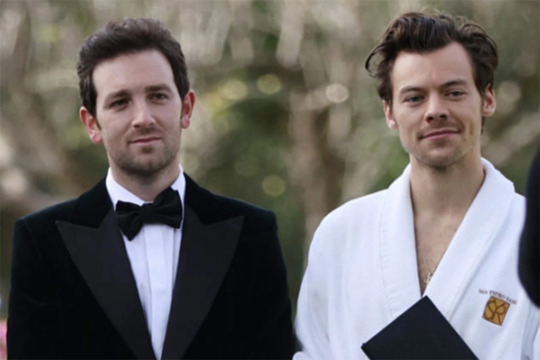
JEFFREY AZOFF: THE CHILD OF NEPOTISM
So for those of you that don't know, Jeffery Azoff is Harry's current manager and the son of Irving Azoff (the third of four kids). He's currently a partner at Full Stop Management, the company owned by Irving and the one artists such as Harry, Haim, the Eagles, Kings of Leon, and Meghan Trainer are signed to.
Jeffrey graduated from the University of Colorado's Leeds School of Business and started working fresh out of college at his father's old Management company (Frontline Management) working under Maroon 5's manager Jordan Feldstein (the only way you get that kind of internship/job as a 21 year old fresh out of college is if your family or family friends gives it to you). He worked here for 5 years.
Direct Quote from Irving Azoff to Jeffrey (really tells you a lot): "Listen carefully, because I’m going to say this one time. You have a phone and you have my last name. If you can’t figure it out, you’re not my son."
After working for his father, Jeffrey moved on to the talent agency CAA (Creative Artist Agency) where he worked for roughly 3 and half years before joining his dad in forming Full Stop Management in 2016.
While he was at CAA, Irving moved over clients like Christina Aguilera and the Eagles to the talent agency to help with tour booking instead of doing it internally through LiveNation (he was CEO).
Even though I'm sure Jeff has had to work somewhat hard to get to where he is (or at least to mess up his dad's work as he doesn't seem like the type to take laziness well), the door into the industry and every job was basically handed to him on a silver platter.
Not to mention if you watch episodes of keeping up with the kardashians (like myself) you can actually see Jeff hanging out with kendall and the rest of the fam at their Palm Springs house (you know you're a nepotism kid if you have an in with the Kardashian crew). Invite me next time Jeffrey!!!
Think of the Azoff's as the mafia family of the music industry, you don't mess with the mafia
-----------------------------------------------------------------------------

THE GRAMMY AWARDS: STUDENT COUNCIL ELECTIONS ON STEROIDS
Ok so here's where we’re going to get into a bit more of the speculation/grey area. I don't need to tell you that award shows are corrupt (See the Golden Globes Emily in Paris scandal) and the Grammys are not an exception. Think of the Grammys as one big student council/government elections where despite the fact the teachers tell you six times to vote for the best candidate, you're still going to vote for your friends even if they aren't the best.
A simplified break-down of Grammy voting:
1) Recording Academy voting members (artists, producers, musicians- anyone involved first hand with the creation of music; All voting members must have been producers, performers or engineers on six or more tracks of a commercially released album (or 12 or more digital tracks) and record labels will submit nominations in various categories to the grammys (songs need to be released commercially between October 1 of the previous year and September 30th of this year). You can also become a voting member by either winning a grammy or being endorsed by a current voting member (hint hint)
2) Once received, the recording academy with have the academy of trustees and its reviewers organize them and approve any changes to the 30 categories/fields (aka they can add new categories or remove old ones; so no best ukulele album of the year -- this is where things get funky)
There's speculation that during this stage when these special groups of 8-10 people are organizing genres, there's an "unwritten rule" that you need to be careful what album you green light (especially for famous artists) if you don't want them to win) (Rob Kenner said this- he used to be on one of these committees). Famous people tend to get more votes from clueless or lay Academy members that don't know the specialized categories or don't care enough to listen to songs that aren't radio trending.
3) After the nominations occur, Voting members begin their first voting. Members can vote for the four general categories of record of the year, album of the year, song of the year and best new artist and a maximum of 15 categories, all within their areas of expertise. Now the interesting thing is that while these are the guidelines there is literally nothing stopping them from voting in whatever categories they want (i.g. a rapper voting in the opera category despite not listening to opera). Theses ballots are all tallied and the top 20 entries are determined in each category (funky moment #2)
In 12 of the 84 categories those top 20 go to the ballot and it's done; for the rest it’s not like that. 59 categories including the big four go to a "nomination review committees" (identities are protected so they can't get lobbied... sure) who take a look at the top 20 and narrow it down to 7 or 8. (these are the special committees the Weekend talked about when he was snubbed). They're supposed to choose the nominees "based solely on the artistic and technical merits of the eligible recordings" which lets be real if that was the case Watermelon Sugar (along with most of the others in the category) I don't think would have been nomimated as they are very generic pop (none of them are special... sorry to the WM lovers out there).
This committee is basically held to THE HONOR CODE SYSTEM... I mean tell me when the last time the honor code system worked in literally any scenario (literally wtf). Don't take my word for it though the former CEO of the Academy Deborah Dugan (a queen) filed a complaint against the Recording Academy basically claiming that the nomination review process was rigged (she was fired after 5 months on the job).
Quote from Deborah Dugan "Members of the board [of trustees] and the secret committees chose artists with whom they have personal or business relationships... It is not unusual for artists who have relationships with Board members and who ranked at the bottom of the initial 20-artist list to end up receiving nominations."
These review committees can also exploit there power by adding up to two nominees that don't appear on the top 20 list to the final voting ballot (except in the 4 big categories - which watermelon sugar that one wasn't nominated for)
They also have craft committees for like non performance stuff (like album notes, engineering and arranging) that don't even get voted on by the academy voting members
4) After all of that fucked up mess, the grammy's decided is ok, the ballots go back to the voting members for the final vote. Deloitte (an accounting firm) then counts all of them, seals them in envelopes, and delivers them to the Grammy award show.
** The Grammy's just announced this year they're removing the "secret committees" so let's see how things shift in the next couple of years**
So obviously I'm not saying this to discredit Harry's nomination or his win as Fine Line was in the US top 20 albums for the majority of 2020, however, we must acknowledge privilege. Harry has a big name to him and a huge following, and while all of that shouldn't be taken into account, it does. He also has the Azoffs, a very well connected family with friends in lots of places that would be able to put in a good word here and there to get support behind Harry. Harry won best pop solo performance for Watermelon Sugar in a category with Doja Cat, Justin Bieber, Billie Eilish, Taylor Swift, and Dua Lipa. Look at the names there, the songs (ya'll can try and remember them cause I'm too lazy to write it out) and tell me that those top names with all of the music produced didn't get there through some connections.
Do with all this information what you will and if you are interested in learning more about the entertainment industry on your own Endeavor (owners of WME, a big talent agency like CAA) is hosting a free online program called the Excellence Program to help guide the future generation of industry executives. The program is a-synchronous and starts on July 12th. Highly recommend giving it a go if you're interested!!!
Alright ya'll that's it. Feel free to message me with your thoughts!
Extra Sources if you'd like to read:
https://www.vice.com/en/article/pkdndn/how-grammys-voting-actually-works-and-where-the-alleged-corruption-lies
https://www.grammy.com/grammys/awards/voting-process
https://www.latimes.com/entertainment-arts/music/story/2020-11-05/irving-azoff-eagles-manager
https://celebrityaccess.com/caarchive/jeffrey-azoff-exits-caa-to-launch-new-management-company/
https://www.rollingstone.com/pro/features/grammy-awards-secret-committees-945532/
https://www.rollingstone.com/music/music-news/grammy-awards-eliminate-secret-committees-voting-changes-1163887/
#harry styles#irving azoff#jeffrey azoff#Grammys#harry styles imagines#harry styles blurb#music industry#endeavor#wme#WME entertainment#Azoff#Harry#harry styles imagine#harry styles fluff#harry styles x reader#harry styles x y/n#harry styles x you#harry styles masterlist#harry styles one shot#harry styles angst
171 notes
·
View notes
Photo

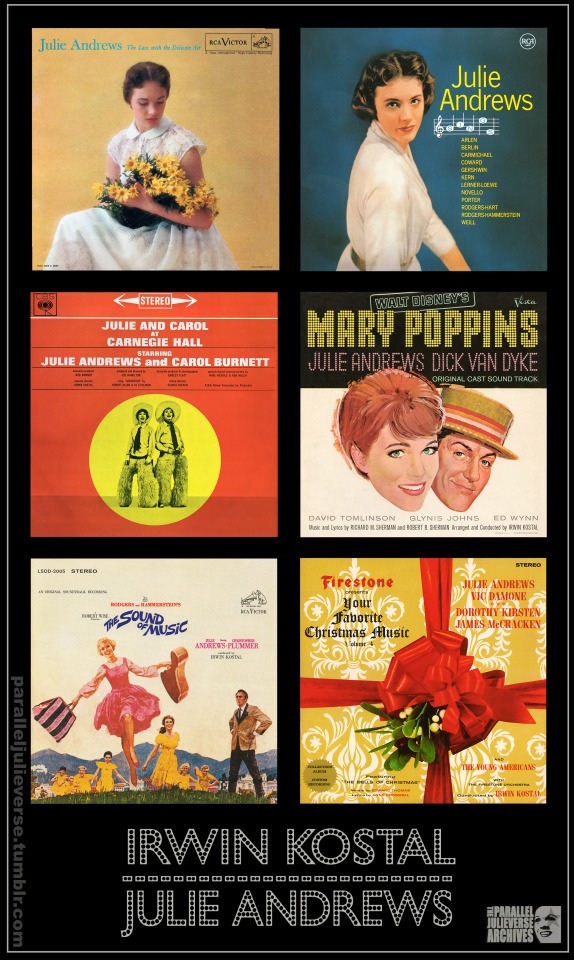

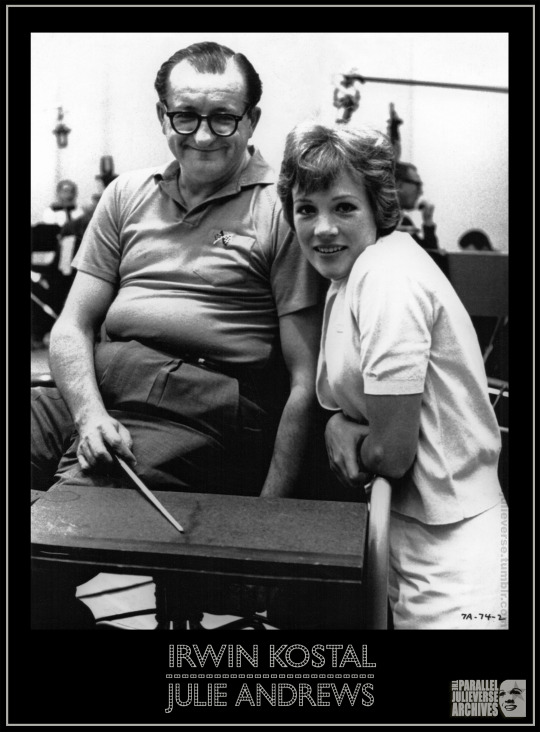
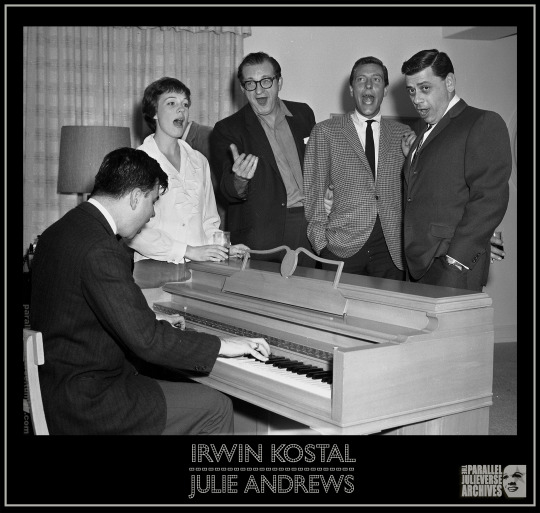
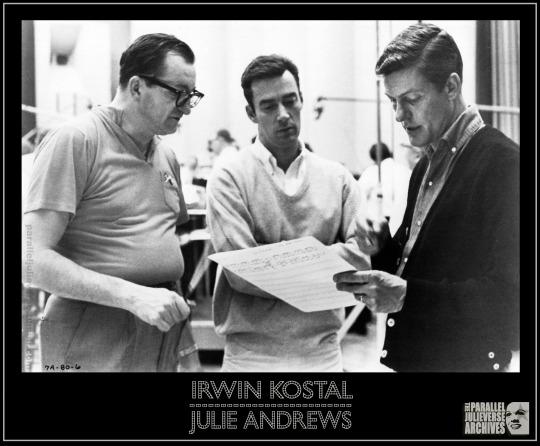
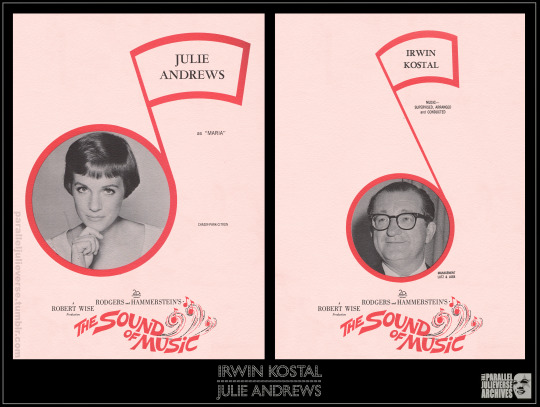
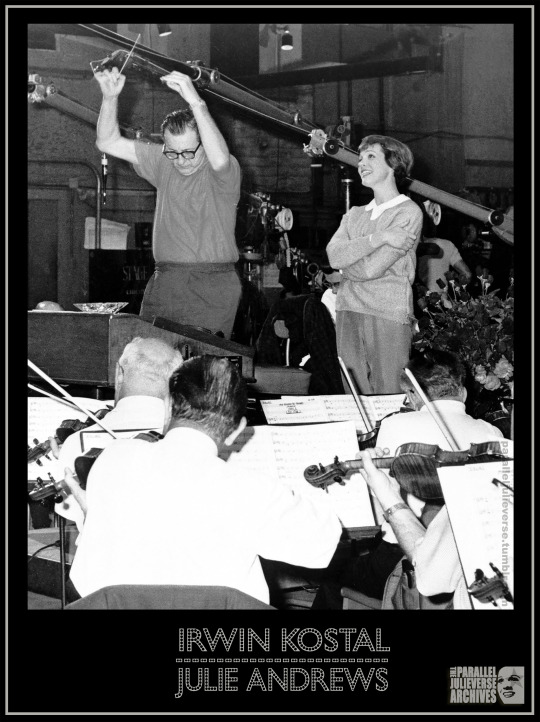

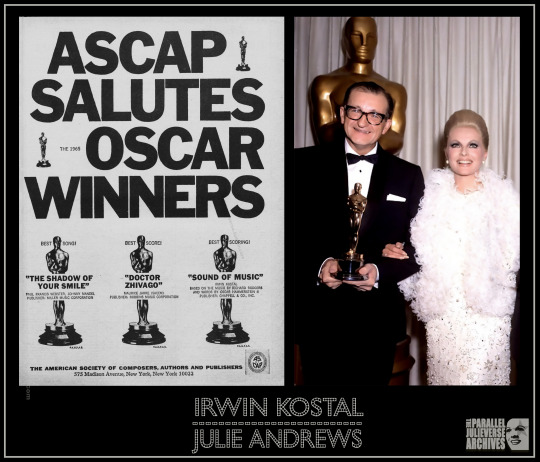
‘Gentlemen like you are few...’: A Supercentenary Tribute to Irwin Kostal
1 October 2021 marks the 110th anniversary of the birth of Irwin Kostal, the musical arranger, orchestrator and conductor whose work helped shape the sound of the post-war American stage and screen musical. In this post we look back at the career of this remarkable 'music man’ with a particular focus on his collaborations with the equally remarkable Julie Andrews -- who, as it happens, shares the same birthday, so this post is doing double birthday honours.
A gentle, unassuming man, Kostal or ‘Irv’ as he was known by associates, was not one for the limelight. It’s possibly why he gravitated to the ‘behind-the-scenes’ art of musical arranging. Unlike composers, performers, or even conductors, arrangers seldom loom large in public perceptions of professional musicianship. They are, for the most part, the ‘invisible artists’ of the music industry: their contributions to the sound and experience of music are immense, but they remain largely ‘uncredited in records, liner notes or books or records’ (Niles 2104, p. 4). That Irwin Kostal would ultimately prove a rare exception to this tradition of thankless anonymity -- becoming sufficiently well-known to have his own name not only included on recordings, but emblazoned on the front cover alongside those of the ‘star’ vocalists with whom he worked -- is a testament to the singularity of his talents.
Born the son of first generation immigrant parents in Chicago in 1911, Kostal claimed he was instantly ‘smitten’ by music when he saw a piano at the age of two-and-a-half, but his family was too poor to afford such luxuries. Moreover, his father -- a hard-drinking Czech with a fiery temper -- was ‘rigidly opposed’ to his interests in music and ‘could see no future in it’ (’Irwin’ 1962, p. 70). So Kostal initially had to content himself with listening and absorbing as much musical knowledge as he could indirectly. When he was eleven, his father finally brought home a broken player piano salvaged from a removals job and it provided the young Kostal with the launch pad he needed.
Kostal devoted himself to his musical education with single-minded zeal. His formal training was intermittent -- enabled by a supportive mother who ‘surreptitiously managed to save money from her weekly allowance for my musical instruction’ (’Irwin’ 1962, p. 70) -- but he was a passionate autodidact who would spend countless hours studying and practising on his own. By age 15, he was already playing professionally with local touring bands, while also offering his own services as a piano teacher with, at one point, more than 40 pupils (ibid.).
When he wasn’t playing, Kostal would be found in the local library poring over musical scores and reading about the greats of the classical canon. He was particularly intrigued by orchestration and the possibilities it offered for varying the sound and feel of music. He recalls how he would take orchestral scores home and study all the parts learning ‘about musical instruments I never knew existed’ (Suskin 2009, p. 56). He progressively worked his way through the music of the masters, going alphabetically:
‘Bach...Beethoven, Brahms, Debussy, Elgar, Frank, Gounod, on and on through the alphabet...I tried to absorb everything. By the time I came to Ravel, Tchaikovsky and Wagner, I knew quite a lot about music in a jumbled way’ (Suskin 2009, p. 57).
While still in his teens, Kostal started to experiment with arrangements of his own, scoring a high school production of Uncle Tom’s Cabin with multiple variations on the American folk melody ‘Way Down upon the Swanee River’. ‘By taking away the rhythmic aspects and playing it in a minor key,’ he recounts, ‘I found lots of ways to play this song, making it fit the dramatics of the half-hour long story’ (ibid., p. 56). Thus, Irwin Kostal the arranger was born.
Throughout the 1930s and early-40s, Kostal honed his talents in a professional capacity, working with various big bands, before finally landing a job as a resident arranger for an NBC radio affiliate in Chicago. Following the war, Kostal moved to New York where, after a rocky start, he secured regular work as conductor and arranger on a number of long-running radio and TV variety shows including Your Show of Shows (1950-54), Max Liebman Presents (1954-56), and The Garry Moore Show (1959-63). It was demanding, fast-paced work with Kostal having to arrange and orchestrate hundreds of score pages a week, but it consolidated his musical versatility and capacity to work across a wide range of styles and forms (Suskin 2009, pp. 57-60).
Throughout this period, Kostal was also orchestrating for Broadway shows, racking up over 52 credits on theatre productions big and small (Allen 1995, p. 18). Many of these assignments were done in a ‘ghost-writer’ capacity including contributing work to such classic musicals as Wonderful Town (1953), The Pajama Game (1953) and Silk Stockings (1955). A major breakthrough came when Kostal was contracted to work in a credited capacity as co-orchestrator on the original Broadway production of West Side Story (1958) -- collaborating with Leonard Bernstein, Stephen Sondheim and Sid Ramin. It earned him his first Grammy Award and a subsequent invitation to arrange and orchestrate a string of other big Broadway musicals including Fiorello! (1959), Sail Away (1961) and A Funny Thing Happened on the Way to the Forum (1962).
The success of West Side Story also saw Kostal do repeat honours on the film version (1961) which would, in turn, earn him an Academy Award and kickstart a hugely successful Hollywood career. In 1963, Kostal was invited by none other than Walt Disney to take on the major job of arranging the songs for Mary Poppins (1964) which had been written by the in-house Disney composing team of Richard M. and Robert B. Sherman. The Sherman Brothers claim to have suggested Kostal because they were fans of his Broadway work and they wanted a bright theatrical sound for the score. However, Walt Disney demurred. He reasoned it was a period film and they needed someone who could write music for any style or era, suggesting they get the musical director from The Garry Moore Show instead. Cue mutual delight when it was discovered they were all referring to the same man, Irwin Kostal (Sherman & Sherman 1998; Suskin 2009, p. 65).
Kostal’s work on Mary Poppins catapulted him to new heights of mainstream success. It not only secured him another Academy Award nomination -- he lost to Andre Previn for his work on My Fair Lady -- but it also brought him a tidy fortune in royalties from the film’s best-selling soundtrack album (’Kostal’s’ $65,000′, 57). His fame -- and fortune -- skyrocketed even further the following year when Kostal was contracted to arrange the score for The Sound of Music (1965). His dazzling efforts on this box-office blockbuster confirmed Kostal’s status as Hollywood’s presiding musical wonder-boy and saw him walk home with his second Oscar. A string of other big screen musicals followed including Half a Sixpence (1967), Chitty Chitty Bang Bang (1968) and Bedknobs and Broomsticks (1971).
Many of these films were repeat collaborations because Kostal favoured working with people he knew and with whom he clicked personally and creatively. He would for example continue as the de facto ‘house’ arranger for Disney well into the 1980s, working on various assignments for the studio including Pete’s Dragon (1978), Mickey’s Christmas Carol (1983) and the controversial re-recorded 1982 release of Fantasia (1940/1982) (Tietyan 1990). Kostal would also maintain a long association with the Sherman Brothers, acting as musical arranger for all their big screen musicals including the aforementioned Chitty Chitty Bang Bang (1968) and Bedknobs and Broomsticks (1971), as well as Tom Sawyer (1973); Charlotte’s Web (1973); and The Magic of Lassie (1978) (Sherman & Sherman 1998).
The other great collaboration of Kostal’s career was of course with Julie Andrews. Perhaps it was the fact that the pair shared the same birthday but Kostal had an extraordinarily sympathetic relationship with Julie and he would work with her more than any other vocalist. Long before they teamed on Poppins and The Sound of Music, Julie and ‘Irv’ were making musical magic together. Kostal was the arranger and conductor for Julie’s first two solo albums for RCA: The Lass with the Delicate Air (1957) and Julie Andrews Sings (1958) where his sensitive facility with a wide range of musical idioms from English classical to Broadway and Tin Pan Alley came to the fore. Reviewing the first of these albums at the time of its original release, one music critic lauded it as ‘a record to charm every member of the family...[with] a combination of sincerity and simplicity and wholesome sweetness...Thank goodness arranger and conductor Irwin Kostal met the challenge and set the ballads winningly without overpowering Miss Andrews’ light pure tones’ (RRS 1958, p. 5A). In a similar vein, another reviewer praised the second album for ‘its charming unforced version of standards, well known and almost forgotten...Miss Andrews still sings naturally and purely [and] the deft accompaniments played by an orchestra under Irwin Kostal are agreeably restrained’ (Masters 1959, p. 11).
In this early period Kostal also worked with Julie as guest star on several episodes of The Garry Moore Show, where he was resident musical director. In this context, Kostal was pivotal in helping establish the legendary teaming of Julie and Carol Burnett which came out of the Garry Moore appearances. He would go on to act as musical director for their breakout 1962 TV special Julie and Carol at Carnegie Hall which would earn Kostal his first Emmy (Taraborelli 1988, pp. 172-79). He would secure his second Emmy a few years later working with Julie again on the 1965 variety special, The Julie Andrews Show (1965) where, among other highlights, Kostal scored a series of stellar song-and-dance medleys for Julie and guest star Gene Kelly. The same year, Kostal teamed up with Julie on yet another recording with the 1965 edition of the annual Firestone Christmas albums.
It was however their combined work on the two big musical mega-hits, Mary Poppins and The Sound of Music, that secured the Kostal-Andrews partnership a place in the history books. A cultural phenomenon of the highest order, the soundtrack recordings for these two films remain among the most successful albums of all time. Mary Poppins held the #1 spot on the US national music charts for 14 consecutive weeks in 1964, beating out Elvis Presley and The Beatles (Hollis and Erhbar 2006, pp.72ff). The album for The Sound of Music sold over 9 million copies in its first four years of release alone, remaining in the Billboard Top 100 for an unbelievable five-and-a-half years, and becoming the highest selling LP of all-time in the US up to that date (Murrells, 1978) The Sound of Music continued its record-breaking run abroad, dominating the international charts and holding the #1 spot for 75 weeks in Australia, 73 weeks in Norway and 70 weeks in the UK, becoming in the process the single biggest selling album worldwide of the 1960s (Harker, 1992, pp. 189-91).
Commentators have frequently singled out the combination of Julie Andrews’ soaring vocals and Kostal’s dynamic arrangements as instrumental to the phenomenal success of these two albums. ‘Miss Andrews glows--positively glows--right through the record groove, vinyl disc, amplifiers, speakers, and all other mechanical barriers,’ enthused one contemporary reviewer of the Mary Poppins soundtrack, noting how the ‘songs that Richard M. and Robert B. Sherman have written’ and ‘the handsome arrangements by Irwin Kostal have the perfect balance ‘of lilt and flair to provide Miss Andrews with an effective working basis’ (Wilson 1965, p. 109). Apropos The Sound of Music, another critic pronounced it ‘as good a reproduction of a score as has ever been made’, noting how it ‘presents Julie in a most appealing role and given the splendid musical direction of Irwin Kostal, her talent comes shining through...as a treat beyond measure’ (Moore 1965, p. B6).
In total, Julie Andrews and Irwin Kostal would work together on six recordings, two musical motion pictures, two television specials, and a host of other TV appearances representing some of the very best of Julie’s musical work during her heyday of the 1960s. Considered alongside the wealth of Kostal’s other work across film, stage, television and recording, it’s hard not to concur with Disney’s Nelson Meecham who, on the occasion of Kostal’s passing in 1994, eulogised: ‘He brought the joy of music to more people than it is possible to count’ (Allen, p. 19).
Sources:
Allen, John F 1995. ‘Remembering a Music Man: On the life and work of Irwin Kostal.’ Boxoffice. August: pp. 18-19.
Harker, Dave 1992. ‘Still Crazy After All These Years: What was popular music in the 1960s?” Cultural Revolution? The challenge of the arts in the 1960s. Bart Moore-Gilbert and John Seed, eds. Routledge, London and New York: pp. 186-200.
Hollis, Tim and Erhbar, Greg 2006. Mouse Tracks: The Story of Walt Disney Records. Jackson: University Press of Mississippi.
‘Irwin Kostal: Music in all its many forms is his life.’ (1962). The Province. 2 June: p. 70.
’Kostal’s’ $65,000 Poppins Score’ 1965. Variety. 10 March: p. 57
Levy, Charles 1964. Mary Poppins: About the stars and photo-story features [Press kit]. Buena Vista Distribution, New York.
Masters, John 1959. ‘Off the Record: Enchanting Music.’ The Age. 7 January: p. 11.
Moore, Robert 1965. ‘Record Turntable: Julie Andrews out in front again in film album of”Sound of Music”.’ The Arizona Daily Star. 7 March: p. B6.
Murrells, Joseph, ed. 1978. Book of Golden Discs: Records that sold a million. Barrie & Jenkins, New York.
Niles, Richard 2014. The Invisible Artist: Arrangers in popular music (1950-2000). BMI, London.
Oliver, Myrna. 1994. ‘Obituaries: Irwin Kostal; Film, TV Orchestrator.’ The Los Angeles Times. 1 December: P. B8.
RRS 1958. ‘On the Record: ‘Lass with the Delicate Air.’ Bristol Herald Courier. 9 February: p. 5A.
Sherman, Robert B & Sherman, Richard M 1998. Walt's Time: From before to beyond. Camphor Tree, Santa Clarita, CA.
Suskin, Steven 2009. The Sound of Broadway Music: A book of orchestrators and orchestrations, Oxford University Press, New York.
Taraborelli, J. Randy 1988. Laughing Till It Hurts: The complete life and career of Carol Burnett. William Morrow & Co, New York.
Tietyan, David 1990. The Musical World of Walt Disney. H. Leonard, Milwaukee, Wis.
Wilson, John S. 1965. ‘The Lighter Side’. High Fidelity Magazine. 15: 4: pp. 107-111.
© 2021, Brett Farmer. All Rights Reserved.
#julie andrews#irwin kostal#musicals#classic film#the sound of music#mary poppins#Disney#Sherman Brothers
21 notes
·
View notes
Text

John Gilbert (born John Cecil Pringle; July 10, 1897 – January 9, 1936) was an American actor, screenwriter and director. He rose to fame during the silent film era and became a popular leading man known as "The Great Lover". His legendary breakthrough came in 1925 with his starring roles in The Merry Widow and The Big Parade. At the height of his career, Gilbert rivaled Rudolph Valentino as a box office draw.
Gilbert's career declined precipitously when silent pictures gave way to talkies. Though Gilbert was often cited as one of the high-profile examples of an actor who was unsuccessful in making the transition to sound films, his decline as a star had far more to do with studio politics and money than with the sound of his screen voice, which was rich and distinctive.
Born John Cecil Pringle in Logan, Utah, to stock-company actor parents, John Pringle (1865–1929) and Ida Apperly Gilbert (1877–1913), he struggled through a childhood of abuse and neglect, with his family moving frequently and young "Jack" having to attend assorted schools throughout the United States. When his family finally settled in California, he attended Hitchcock Military Academy in San Rafael. After he left school, Gilbert worked as a rubber goods salesman in San Francisco, then performed with the Baker Stock Company in Portland, Oregon, in 1914. He subsequently found work the following year as a stage manager in another stock company in Spokane, Washington, but he soon lost that job when the company went out of business.
After losing his stage job in 1915, Gilbert decided to try screen acting, and he quickly gained work as a film extra through Herschell Mayall. Gilbert first appeared in The Mother Instinct (1915), a short directed by Wilfred Lucas. He then found work as an extra with the Thomas Ince Studios in productions such as The Coward (1915), Aloha Oe (1915), Civilization (1915), The Last Act (1916), and William Hart's Hell's Hinges (1916).
During his initial years in films, Gilbert also performed in releases by Kay-Bee Company such as Matrimony (1915), The Corner (1915), Eye of the Night (1916), and Bullets and Brown Eyes (1916). His first major costarring role was as Willie Hudson in The Apostle of Vengeance, also with William S. Hart.[6] Viewed by studio executives as a promising but still "juvenile" actor at this stage of his career, Gilbert's contract salary was $40 a week ($940 today), fairly ample pay for most American workers in the early 1900s.[7] Gilbert continued to get more substantial parts at Kay-Bee, which billed him as "Jack Gilbert" in The Aryan (1916), The Phantom (1916), Shell 43 (1916), The Sin Ye Do (1917), The Weaker Sex (1917), and The Bride of Hate (1917). His first true leading role was in Princess of the Dark (1917) with Enid Bennett, but the film was not a big success and he went back to supporting roles in The Dark Road (1917), Happiness (1917), The Millionaire Vagrant (1917), and The Hater of Men (1917).
Gilbert went over to Triangle Films where he was in The Mother Instinct (1917), Golden Rule Kate (1917), The Devil Dodger (1917) (second billed), Up or Down? (1917), and Nancy Comes Home (1918). For Paralta Plays, Gilbert did Shackled (1918), One Dollar Bid (1918), and Wedlock (1918) and More Trouble (1918) for Anderson, but the company went bankrupt.[7] He also was cast in Doing Their Bit (1918) at Fox and then returned to Triangle for The Mask (1918). Gilbert also did Three X Gordon (1918) for Jesse Hampton, The Dawn of Understanding (1918), The White Heather (1919) for Maurice Tourneur, The Busher (1919) for Thomas Ince, The Man Beneath for Haworth, A Little Brother of the Rich (1919) for Universal, The Red Viper (1919) for Tyrad, For a Woman's Honor (1919) for Jess Hampton, Widow by Proxy (1919) for Paramount, Heart o' the Hills (1919) for Mary Pickford, and Should a Woman Tell? (1919) for Screen Classics.
Maurice Tourneur signed him to a contract to both write and act in films. Gilbert performed in and co-wrote The White Circle (1920), The Great Redeemer (1921), and Deep Waters (1921). As a writer only, he worked on The Bait (1921), which starred and was produced by Hope Hampton. For Hampton, Gilbert wrote and directed as well, but he did not appear in Love's Penalty (1921).
In 1921, Gilbert signed a three-year contract with Fox Film Corporation, which subsequently cast him in romantic leading roles and promoted him now as "John Gilbert". The actor's first starring part for the studio was in Shame (1921).[10] He followed it with leading roles in Arabian Love (1922), Gleam O'Dawn (1922), The Yellow Stain (1922), Honor First (1922), Monte Cristo (1922), Calvert's Valley (1922), The Love Gambler (1922), and A California Romance (1922). Many of the scenarios for these films were written by Jules Furthman.
Gilbert returned temporarily to Tourneur to costar with Lon Chaney in While Paris Sleeps (1923). Back at Fox, he starred in Truxton King (1923), Madness of Youth (1923), St. Elmo (1923), and The Exiles (1923). The same year he starred in Cameo Kirby (1923), directed by John Ford, co starring Jean Arthur. He went into The Wolf Man (1923) with Norma Shearer, not a horror film, but the story of a man who believes he murdered his fiancée's brother while drunk. Gilbert also performed in his last films for Fox in 1924, including Just Off Broadway, A Man's Mate, The Lone Chance, and Romance Ranch.
Under the auspices of movie producer Irving Thalberg, Gilbert obtained a release from his Fox contract and moved to MGM, where he became a full-fledged star cast in major productions. First starring in His Hour (1924) directed by King Vidor and written by Elinor Glyn his film career entered its ascendancy. He followed this success with He Who Gets Slapped (1924) co-starring Chaney and Shearer and directed by Victor Sjöström; The Snob (1924) with Shearer; The Wife of the Centaur (1924) for Vidor.
The next year, Gilbert would star in two of MGM's most critically acclaimed and popular film productions of the silent era: Erich von Stroheim's The Merry Widow and King Vidor's The Big Parade.
Gilbert was assigned to star in Erich von Stroheim's The Merry Widow by Irving Thalberg, over the objections of the Austrian-American director. Von Stroheim expressed his displeasure bluntly to his leading man: "Gilbert, I am forced to use you in my picture. I do not want you, but the decision was not in my hands. I assure you I will do everything in my power to make you comfortable." Gilbert, mortified, soon stalked off the set in a rage, tearing off his costume. Von Stroheim followed him to his dressing room and apologized. The two agreed to share a drink. Then Gilbert apologized and they had another drink. The tempest subsided and was resolved amicably. According to Gilbert, the contretemps served to "cement a relationship which for my part will never end."
The public adulation that Gilbert experienced with his growing celebrity astounded him: "Everywhere I hear whispers and gasps in acknowledgment of my presence... he whole thing became too fantastic for me to comprehend. Acting, the very thing I had been fighting and ridiculing for seven years, had brought me success, riches and renown. I was a great motion picture artist. Well, I’ll be damned!"
Gilbert was next cast by Thalberg to star in the King Vidor's war-romance The Big Parade (1925), which became the second-highest grossing silent film and the most profitable film of the silent era. Gilbert's "inspired performance" as an American doughboy in France during World War I was the high point of his acting career. He fully immersed himself in the role of Jim Apperson, a Southern gentleman who, with two working class comrades, experiences the horrors of trench warfare. Gilbert declared: "No love has ever enthralled me as did the making of this picture...All that has followed is balderdash."
The following year, Vidor reunited Gilbert with two of his co-stars from that picture, Renée Adorée and Karl Dane, for the film La Bohème (1926) which also starred Lillian Gish. He then did another with Vidor, Bardelys the Magnificent (1926).
In 1926, Gilbert made Flesh and the Devil (1926), his first film with Greta Garbo. Gilbert first encountered Garbo on the set during filming of the railway station scene, and the chemistry between the two was evidently instantaneous. Director Clarence Brown remarked approvingly that he "had a love affair going for me that you couldn’t beat, any way you tried." Garbo and Gilbert soon began a highly publicized romance, much to the delight of their fans and to MGM.
He made The Show (1927) with Adoree for Tod Browning then did Twelve Miles Out (1927) with Joan Crawford and Man, Woman and Sin (1927) with Jeanne Eagels.
Gilbert was reunited with Garbo in a modern adaptation of Tolstoy's 19th-century novel, Anna Karenina. The title was changed to Love (1927) to capitalize on the real life love affair of the stars and advertised by MGM as "Garbo and Gilbert in Love."
Gilbert made The Cossacks (1928) with Adoree; Four Walls (1928) with Crawford; Show People (1928) with Marion Davies for Vidor, in which Gilbert only had a cameo; and The Masks of the Devil (1928) for Victor Sjöström.
Though officially directed by Edmund Goulding, Gilbert, though uncredited, was responsible for directing the love scenes involving Garbo. He was perhaps the only person in the industry whose "artistic judgment" she fully respected. As such, MGM approved of this arrangement.
Gilbert and Garbo were teamed for a third time in A Woman of Affairs (1928). His last silent film was Desert Nights (1929).
With the coming of sound, Gilbert's vocal talents made a good first impression, though the studio had failed to conduct a voice test. The conventional wisdom of the day dictated that actors in the new talkies should emulate "correct stage diction". Gilbert's strict adherence to this method produced an affected delivery that made audiences giggle, and not due to any particularity in Gilbert's natural speech. Indeed, the "quality of his voice compared well with that of co-star Conrad Nagel, regarded as having one of the best voices for sound."
Gilbert signed an immensely lucrative multi-picture contract with MGM in 1928 that totaled $1,500,000. The terms of the agreement positioned MGM executives Irving Thalberg and Nicholas Schenck, both sympathetic to the star, to supervise his career. Gilbert, however, frequently clashed with studio head Louis B. Mayer over creative, social and financial matters. A confrontation between the two men, one that became physical, occurred at the planned double-wedding of Garbo and Gilbert and director King Vidor and actress Eleanor Boardman. Mayer reportedly made a crude remark to Gilbert about Garbo, and Gilbert reacted by knocking Mayer to the floor with his fist.[24] While this story has been disputed or dismissed as hearsay by some historians, Vidor's bride Eleanor Boardman insisted that she actually witnessed the altercation.
In the all-star musical comedy The Hollywood Revue of 1929 (1929), Gilbert and Norma Shearer played the balcony scene from Shakespeare's Romeo and Juliet, first as written, then followed with a slang rendition of the scene. The comic effect served to "dispell the bad impression" produced by Gilbert's original "mincing" delivery.
Audiences awaited further romantic roles from Gilbert on the talking screen. The next vehicle was the Ruritanian romance His Glorious Night (1929), directed by Lionel Barrymore. According to reviewers, audiences laughed nervously at Gilbert's performance. The offense was not Gilbert's voice, but the awkward scenario along with the overly ardent love scenes. In one, Gilbert keeps kissing his leading lady, (Catherine Dale Owen), while saying "I love you" over and over again. (The scene was parodied in the MGM musical Singin' in the Rain (1952) in which a preview of the fictional The Dueling Cavalier flops disastrously.)
Director King Vidor speculated that the late Rudolph Valentino, Gilbert's main rival for romantic leads in the silent era, probably would have suffered the same fate in the talkie era had he lived. Gilbert's inept phrasing, his "dreadful enunciation" and the "inane" script as the genuine sources of his poor performance, that drew "titters" from audiences.
The persistent myth that John Gilbert had a "squeaky voice" that doomed his career in sound films first emerged from his performance in 1929 with His Glorious Night. It was even rumored that Louis B. Mayer ordered Gilbert's voice to be gelded by manipulating the sound track to give it a higher, less masculine pitch. Later, after analyzing the film's sound track, British film historian Kevin Brownlow found that the timbre and frequency of Gilbert's speaking scenes in His Glorious Night were no different than in his subsequent talkies. Brownlow also reported from that analysis that Gilbert's voice, overall, was "quite low". With regard to the alleged manipulation of Gilbert's footage by Mayer or by anyone else, television technicians in the 1960s determined that the actor's voice was consistent with those of other performers on the same print, casting doubt that any targeted "sabotaging" of Gilbert's voice occurred.
Film critic John Baxter described Gilbert as having "a light speaking voice", a minor defect that both MGM and the star "magnified into an obsession." Despite any conflicting opinions or myths surrounding the actor's voice, Mayer's lingering resentment and hostility toward Gilbert remained apparent, especially after MGM's star signed a new contract for six pictures at $250,000 each. Those ill feelings fueled additional speculation that Mayer deliberately assigned Gilbert bad scripts and ineffective directors in an effort to void the contract.
Metro-Goldwyn-Mayer cast Gilbert in a film adaption of The Living Corpse by Tolstoy re-titled as Redemption (1929). The bleak atmosphere and maudlin dialogue presaged the disaster looming in the stars’ personal life and career. Gilbert's confident screen presence had vanished, while his use of the exaggerated stage diction that elicited laughs from the audience persisted. In one scene Gilbert declares ominously "I’m going to kill myself to let the whole world know what it has lost."[34]
MGM put him in a more rugged film, Way for a Sailor (1930) with Wallace Beery. He followed it with Gentleman's Fate (1931). Gilbert became increasingly depressed by progressively inferior films and idle stretches between productions. Despite efforts by studio executives at MGM to cancel his contract, Gilbert resolved to thwart Louis B. Mayer and see the six-picture ordeal through to the end.
Gilbert's fortunes were temporarily restored when MGM's production chief Irving Thalberg gave him two projects that were character studies, giving Gilbert an excellent showcase for his versatility. The Phantom of Paris (1931), originally intended for Lon Chaney (who died from cancer in 1930), cast Gilbert as a debonair magician and showman who is falsely accused of murder and uses his mastery of disguise to unmask the real killer.
Downstairs (1932) was based on Gilbert's original story, with the actor playing against type as a scheming, blackmailing chauffeur. The films were well received by critics and fans but failed to revive his career. In between, he appeared in West of Broadway (1931). Shortly after making Downstairs, he married co-star Virginia Bruce; the couple divorced in 1934.
Gilbert fulfilled his contract with MGM with a perfunctory "B" picture – Fast Workers (1933) directed by Browning. He left the studio in 1933, terminating his $10,000 a week contract.
Exhausted and demoralized by his humiliations at MGM and his declining success at the box office, Gilbert began to drink heavily, contributing to his declining physical and mental health.
Gilbert announced his retirement from acting and was working at Fox as an "honorary" director when, in August 1933, Gilbert announced he had signed a seven-year contract with MGM at $75–100,000 a picture. The reason was Greta Garbo insisted that Gilbert return to MGM to play her leading man in Queen Christina (1933), directed by Rouben Mamoulian. Garbo was top-billed, with Gilbert's name beneath the title. Queen Christina, though a critical success, did not revive Gilbert's poor self-image or his career. Garbo was reported to have dropped the young Laurence Olivier scheduled to play the part, but director Rouben Mamoulian recalled that Olivier's screen tests had already eliminated him from consideration.
Columbia Pictures gave Gilbert what would be his final chance for a comeback in The Captain Hates the Sea (1934) in which he gave a capable performance as "a dissipated, bitter [and] cynical" playwright. But the off-screen cast of heavy drinkers encouraged his alcoholism. It was his last film.
Biographer Kevin Brownlow's eulogy to John Gilbert considers the destruction of both the man and his career:
"The career of John Gilbert indicates that the star, and the person playing the star, were regarded by producers as separate entities, subject to totally different attitudes. Gilbert, as an ordinary human being, had no legal right to the stardom that was the sole property of the studio. When Gilbert, as an employee, tried to seize control of the future of Gilbert the star, the studios decided to save their investment from falling into the hands of rivals, [so] they had to wreck their property. Other properties – books, films, sets – could be destroyed with impunity. But the destruction of a star carried with it the destruction of a person…it seems somewhat abhorrent that it took such tragedies as that of John Gilbert to bring us our entertainment."
Gilbert was married four times. His first marriage, on August 26, 1918, was to Olivia Burwell, a native of Mississippi whom Gilbert had met after her family moved to California. They separated the following year and Burwell returned to Mississippi for a while. She filed for divorce in Los Angeles in 1921.
In February 1921, Gilbert announced his engagement to actress Leatrice Joy. They married in Tijuana in November 1921.[44] As Gilbert had failed to secure a divorce from his first wife and the legality of Gilbert and Joy's Mexican marriage was questionable, the couple separated and had the marriage annulled to avoid a scandal. They remarried on March 3, 1922. The marriage was tumultuous and, in June 1923, Joy filed for legal separation after she claimed that Gilbert slapped her face after a night of heavy drinking. They reconciled several months later. In August 1924, Joy, who was pregnant with the couple's daughter, filed for divorce. Joy later said she left Gilbert after discovering he was having an affair with actress Laurette Taylor.[47] Joy also claimed that Gilbert had conducted affairs with Barbara La Marr (with whom he had a romance before his marriage to Joy), Lila Lee and Bebe Daniels. Gilbert and Joy had a daughter, Leatrice Gilbert (later Fountain; 4 September 1924 – 20 January 2015). Joy was granted a divorce in May 1925.
In 1929, Gilbert eloped with actress Ina Claire to Las Vegas. They separated in February 1931 and divorced six months later. Gilbert's fourth and final marriage was on August 10, 1932, to actress Virginia Bruce, who had recently costarred with him on the MGM film Downstairs. The entertainment trade paper The Film Daily reported that their "quick" wedding was held in Gilbert's dressing room on the MGM lot while Bruce was working on another studio production, Kongo. Among the people attending the small ceremony were the head of MGM production Irving Thalberg, who served as Gilbert's best man; screenwriter Donald Ogden Stewart, whose wife Beatrice acted as Bruce's matron of honor; MGM art director and set designer Cedric Gibbons; and his wife, actress Dolores del Río. Bruce retired briefly from acting following the birth of their daughter Susan Ann; however, she resumed her career after her divorce from Gilbert in May 1934.
Before his death, Gilbert dated actress Marlene Dietrich as well as Greta Garbo. When he died, he had recently been slated to play a prominent supporting role in Dietrich's film Desire.
By 1934, alcoholism had severely damaged Gilbert's health. He suffered a serious heart attack in December 1935, which left him in poor health. Gilbert suffered a second heart attack at his Bel Air home on January 9, 1936, which was fatal.
A private funeral was held on January 11 at the B.E. Mortuary in Beverly Hills. Among the mourners were Gilbert's two ex-wives, Leatrice Joy and Virginia Bruce, his two daughters, and stars Marlene Dietrich, Gary Cooper, Myrna Loy, and Raquel Torres.
Gilbert was cremated and his ashes were interred at Forest Lawn Memorial Park, Glendale in Glendale, California.
Gilbert left the bulk of his estate, valued at $363,494 (equivalent to $6.7 million in 2019), to his last ex-wife Virginia Bruce and their daughter, Susan Ann. He left $10,000 to his eldest daughter Leatrice, and other amounts to friends, relatives and his servants.
For his contribution to the motion picture industry, Gilbert has a star on the Hollywood Walk of Fame at 1755 Vine Street. In 1994, he was honored with his image on a United States postage stamp designed by caricaturist Al Hirschfeld.
#john gilbert#silent era#silent hollywood#silent movie stars#golden age of hollywood#classic movie stars#classic hollywood#old hollywood#1910s movies#1920s hollywood#1930s hollywood
18 notes
·
View notes
Text
Helen Hayes in Hollywood By Kim Luperi
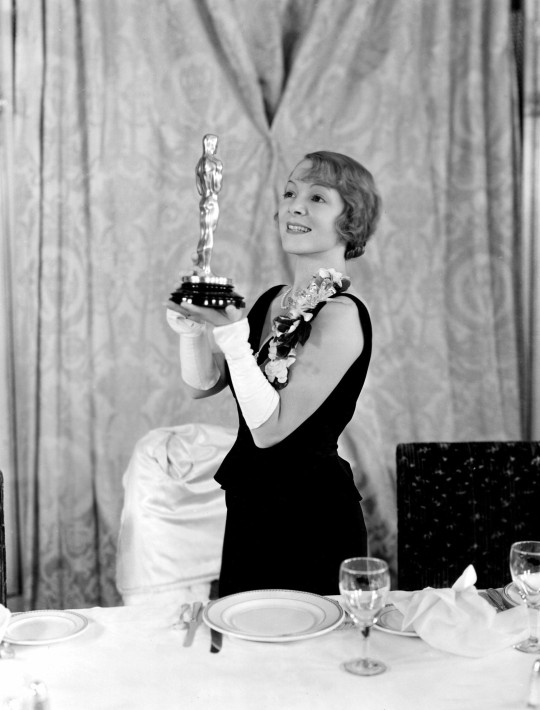
For someone who didn’t particularly enjoy her Hollywood experience, Helen Hayes sure achieved a lot. Just to name a few accomplishments, she’s:
The first stage actress to take home an Oscar, for 1931’s THE SIN OF MADELON CLAUDET
The first woman to win Best Actress and Best Supporting Actress Oscars, holding the record for longest gap between awards with 39 years separating her first win and her last
One of the first EGOT winners, picking up one Emmy, one Grammy, two Oscars and two Tonys throughout her career
And she did all that while appearing in less than 20 films due to a rocky relationship with Hollywood, which speaks even more to her incredible talent.
Hayes’ career began in Washington, D.C. stage productions at the ripe old age of five; by eight, she hit the Great White Way, making her Broadway debut in 1909’s Old Dutch. After touring with Pollyanna as a teenager, Hayes saw her star rise throughout the 1920s with roles in plays such as Caesar and Cleopatra and Coquette. In 1928, the actress wed writer Charles MacArthur, the same year The Front Page, which he’d co-written with Ben Hecht, debuted to rave reviews. It wasn’t long before Hollywood came calling for MacArthur, but Hayes stayed in New York – at first. A huge Broadway star at that point, Hayes turned down multiple studio offers as friends dissuaded her from leaving the “legitimate” stage for movies. But when the Great Depression starting to affect theater attendance, Hayes gave in and signed a lucrative seven-year contract with MGM that allowed her to take on occasional Broadway roles.

However, MGM wasn’t exactly sure what to do with her. Compared to stars like the enigmatic Greta Garbo, Hayes was considered a plain Jane. “There were so many things I didn’t have or wasn’t,��� the actress recalled in her 1990 autobiography Helen Hayes: My Life in Three Acts. “But Mr. Mayer had an idea. I would be promoted as ‘The Great Actress.’” And in the early 1930s, that meant melodrama, which suited her so well that she won an Oscar for THE SIN OF MADELON CLAUDET, the first of her Hollywood features released. For the next four years, Hayes found herself relegated to prestige fare like ARROWSMITH (‘31) and A FAREWELL TO ARMS (‘32).
One of Hayes’ favorite stage roles was the 1926 revival of J.M. Barrie’s What Every Woman Knows. She played Maggie, a modest woman who provides the power behind her husband’s successes. Hayes particularly adored the character’s understanding nature and wit. According to Kenneth Barrow’s book Helen Hayes: First Lady of the American Theatre, the actress suggested to MGM executive Irving Thalberg that the studio purchase the rights to the play.
But any high hopes Hayes held for the adaptation – her only stage role that she’d immortalize on film – were dashed quickly. Upon reading the script, Hayes recalled that Barrie’s humor was “torn apart in the most insensitive way.” “I protested, but was told to stick to acting and let others worry about writing and directing,” she stated. Perhaps Hayes was on to something, because WHAT EVERY WOMAN KNOWS (‘34) faced a discouraging initial test screening. Retakes followed, with director Gregory La Cava adding comedy that his star didn’t find true to the source material. “We’ll do it my way,” La Cava proclaimed. “It was then and there that I decided I would devote my efforts to the stage,” Hayes remembered.

Indeed, upon leaving Hollywood for her next Broadway play, Hayes informed MGM managing director Eddie Mannix that she wanted out of her contract. To her surprise, Mannix wouldn’t let her and if she didn’t come back, he told her MGM would sue for the money they spent on her next (and final) picture under contract, VANESSA, HER LOVE STORY (’35).
Despite the negative experience, WHAT EVERY WOMAN KNOWS received glowing reviews and Hayes earned positive notices for her charm and sincerity. However, Hollywood still didn’t suit her. For one, the actress found it hard to adapt to the slow, repetitive pace and “jigsaw-puzzle” approach of movies. “Only a short part of each day was spent acting; the rest was a game of patience,” Hayes remembered in 1990. The way of life also created an imbalance in her family, as Hayes and MacArthur rarely found themselves sharing time together with their daughter.
Upon leaving Hollywood in 1935, Hayes confided to a reporter: “I don’t think I’m much good in pictures, and I have a beautiful dream that I’m elegant on stage.” Over the next several decades Hayes would continue to win awards for her stage and television work, but she’d underestimated her own prowess on the screen, as she nabbed one more Oscar for 1970’s AIRPORT.
50 notes
·
View notes
Text
JACK BENNY’S 20th ANNIVERSARY SPECIAL
November 16, 1970

Produced by: Irving Fein, Stan Harris
Directed by: Stan Harris, Paul Heslin
Written by: Hal Goldman, Al Gordon, Hilliard Marks, Hugh Wedlock Jr.
Starring the Cast of “The Jack Benny Program”
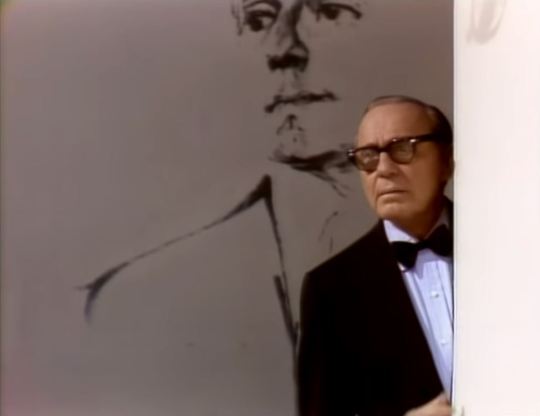
Jack Benny (Himself) was a Beverly Hills neighbor of Lucille Ball’s and the two were off-screen friends. Benny appeared on “The Lucy Show” as Harry Tuttle (a Jack Benny doppelganger) in “Lucy and the Plumber” (TLS S3;E2), later did a voice over cameo as himself in “Lucy With George Burns” (TLS S5;E1), and played himself in “Lucy Gets Jack Benny’s Account” (TLS S6;E6). He was seen in four episodes of “Here’s Lucy.” Benny and Ball appeared on many TV variety and award shows together. He died in 1974, a few weeks after taping “An All-Star Party for Lucille Ball.”
Mary Livingstone (Herself) married Jack Benny in 1927 and the pair remained together until his death in 1974. Initially an actor who appeared on Benny’s radio and television programs, she retired from show business in 1958, at the same time as Gracie Allen, wife of George Burns. Her voice (lip synched by Lucy) was used in “Lucy and Jack Benny's Biography” (HL S3;E11). She died in 1983.
This is Livingstone's first appearance on her husband's television show in fifteen years.
Don Wilson (Announcer. Himself) was a portly man with a deep resonating voice that made him very popular with sponsors in the early days of radio. He teamed with Jack Benny on radio and when Benny made the move to television, Wilson made the move as well, until 1965, when “The Jack Benny Program” ended.
Dennis Day (Himself) was an Irish singer who’s name and career were synonymous with Jack Benny’s, working with the comedian on radio and TV. It was Benny who gave him his big break in 1939 and Benny who kept him employed as a singer and naive comic sidekick. His “Gee, Mr. Benny!” became a well-known catchphrase. Day would play second banana to the comedian until Benny’s death in 1974. Day played an elderly bachelor hunting on a 1967 episode of “The Lucy Show” (S6;E7). Day died at age 72 of Lou Gehrig’s disease.
Day's real-life wife, Peggy Almquist, and his ten children Tommy, Pat, Margaret, Eileen, Danny, Therese, Cathy, Mary Kate and twins Michael and Paul. The childrens' surname was McNulty, Day's birth name. None of the family are credited.
Eddie Anderson (Rochester) was Jack Benny’s valet and sidekick first on radio and then on television. He co-starred with Lucille Ball on “Stars in the Eye” (1952) and one other Jack Benny special in 1969.
Mel Blanc (Sy / Airport Voice) is best known as the voice of Bugs Bunny and other Warner Brothers characters, but had acted with Lucille Ball on radio and in the 1950 film The Fuller Brush Girl. He did some voice dubbing (ADR) on “Lucy Goes To The Air Force Academy: Part 2” (HL S2;E2) in 1969.
Frank Nelson (Ticket Clerk) is the only actor to play two recurring roles on “I Love Lucy”: Freddie Fillmore and Ralph Ramsey. He also appeared as six other characters. He appeared in the first of the "The Lucy–Desi Comedy Hours” as well as a 1963 episode of “The Lucy Show.”
Benny Rubin (Information Desk Clerk) played the snarky Hollywood Bus Driver in “The Tour” (ILL S4;E30). His first ���Lucy Show” appearance was in “Lucy and the Runaway Butterfly” (S1;E29) and he was also seen in “Lucy and Viv Open a Restaurant” (S4;E20) in 1964.
Guest Stars
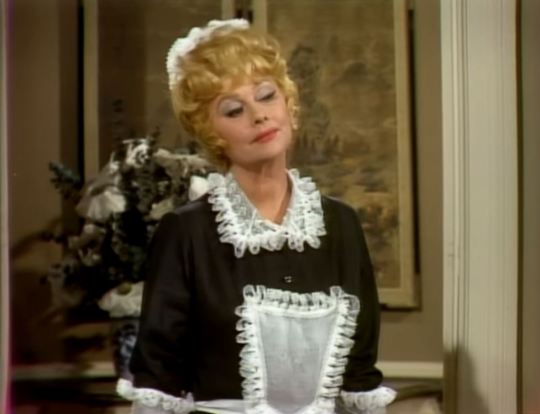
Lucille Ball (Janet, Benny's Maid) played all of the women in Jack Benny's life (including Mary Livingstone) on her own show in “Lucy and Jack Benny's Biography” (HL S3;E11) which aired just one week after this special. Benny paid tribute to Lucy on “An All-Star Party for Lucille Ball” (1974) just prior to his death.
Ball receives no screen credit but gets a verbal thank you from Benny at show's conclusion. Lucy has three lines and 30 seconds screen time!
Frank Sinatra (Himself) had appeared on “The Jack Benny Program” in 1951. Benny returned the favor by appearing on “The Frank Sinatra Show” that same year. Sinatra inadvertently appeared on “I Love Lucy” when a clip from his film Guys and Dolls was inserted into “Lucy and the Dummy” (ILL S5;E3) in 1955.
Sinatra is billed as 'Special Guest Star' in the opening credits.
Bob Hope (Himself) was born Lesley Townes Hope in England in 1903. During his extensive career in virtually all forms of media he received five honorary Academy Awards. In 1945 Desi Arnaz was the orchestra leader on Bob Hope’s radio show. Ball and Hope did four films together. He appeared as himself on the season 6 opener of “I Love Lucy.” He did a brief cameo in a 1964 episode of “The Lucy Show.” When Lucille Ball moved to NBC in 1980, Hope appeared on her welcome special. He died in 2003 at age 100.
Dinah Shore (Herself) was born Fannye Rose Shore in 1916. She was a singer, actress, and television personality, and the top-charting female vocalist of the 1940s. She rose to prominence as a recording artist during the Big Band era, but achieved even greater success a decade later, in television, mainly as hostess of a series of variety programs. She later changed her named to Dinah after her success with the song of the same name. She was famous for blowing a kiss to her audiences (“Mwah!”) at the end of each show. She appeared on “Here's Lucy” as herself in 1971. Her passions were golf, cooking, and painting. Shore died in 1994.
Dean Martin (Himself) was born Dino Paul Crocetti in Steubenville, Ohio, in 1917. He made his screen debut in a short playing a singer in Art Mooney’s band, but his first big screen role was 1949’s My Friend Irma with Jerry Lewis. This began a partnership that would be one of the most successful screen pairings in cinema history. Later, he also worked frequently members of “the Rat Pack”: Frank Sinatra, Joey Bishop, Peter Lawford, and Sammy Davis Jr. His persona was that of a playboy, usually seen with a glass of booze and a cigarette. Martin and Lucille Ball appeared on many TV variety and award shows together and made the TV movie “Lucy Gets Lucky” in 1975. He played himself (and his stunt man double) on “The Lucy Show” on Valentine's Day 1966. He died on Christmas Day in 1995 at age 78.
Martin receives no screen credit but gets a verbal thank you from Benny at show's conclusion
Red Skelton (Western Union Messenger) was born Richard Skelton in 1913. He left school after the third grade to join a traveling medicine show and from there entered vaudeville. His first film was Having Wonderful Time in 1938, which is where he first met Lucille Ball. The pair went on to appear together in Du Barry Was a Lady (1943), Thousands Cheer (1943), Ziegfeld Follies (1945), and The Fuller Brush Girl (1950). Skelton played himself on “Lucy Goes To Alaska” (LDCH 1959). He did two episodes of “The Jack Benny Program” in 1956 and 1958. He died in 1997 at the age of 84.
Skelton receives no screen credit but gets a verbal thank you from Benny at show's conclusion
George Burns (Voice of the Talking Telegram) was born Nathan Birnbaum in New York City in January 1896. He married Gracie Allen in 1926 and the two formed an act (Burns and Allen) that toured in vaudeville. They had their own hit show “The George Burns and Gracie Allen Show” first on radio then on CBS TV from 1950 to 1958, airing concurrently with “I Love Lucy.” He appeared as himself on “The Lucy Show” (S5;E1) in 1966 as well as doing a cameo on “Lucy and Jack Benny’s Biography” (HL S3;E11) in 1970. After Allen’s death in 1964, Burns reinvented himself as a solo act. In 1976 he won an Oscar for playing one of The Sunshine Boys. He was also known for playing the title role in Oh, God! (1978) and its 1984 sequel Oh, God! You Devil. Burns and Ball appeared on many TV variety and award shows together. He died at the age of 100.
Burns receives no screen credit but gets a verbal thank you from Benny at show's conclusion
David Westberg (Helicopter Pilot)
Verbal credit from Don Wilson at show's conclusion.
Trained Penguins (courtesy of Sea World San Diego) formerly worked for Jack Benny in “Jack Benny's Birthday Special” (February 17, 1969).
TRIVIA
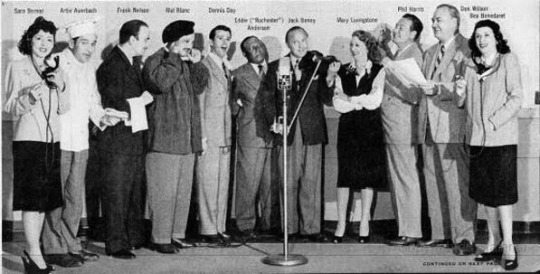
This is the last television show that reunited the entire cast of the Jack Benny radio show. Most of the cast made appearances on Jack Benny's television show as well.
Jack Benny had his own radio program since 1932. He brought the program to television (along with his radio regulars) on October 28, 1950. Jack remained thirty-nine-years-old, kept his money in his basement, and drove his old Maxwell car, just as he had done on radio. The television show ran until 1965. For the first five years, the show aired concurrently on radio and television. The TV program produced 931 episodes. It won an Emmy Award for best comedy show in 1961.

In October 1964, Lucille Ball was featured on a program where she played Mrs. Paul Revere. After the regular half hour show was canceled, Benny embarked on a series of bi-annual specials. Lucille Ball appeared on three of these specials.
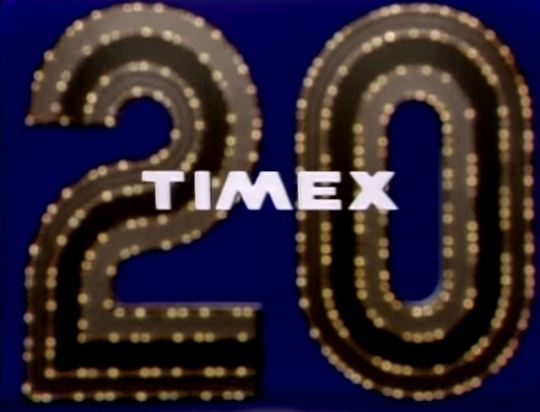
This show was sponsored by Timex.
As always, Jack Benny's theme song is “Love in Bloom.”
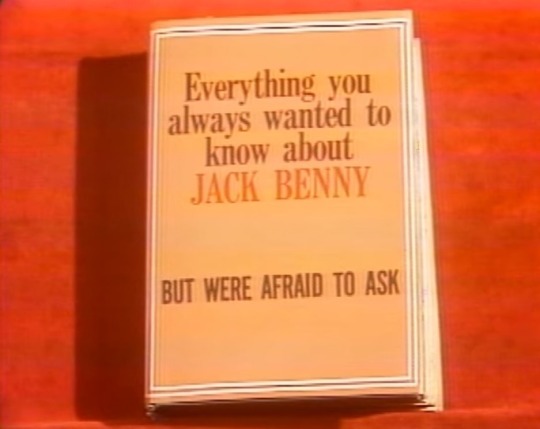
In the subsequent special “Everything You Always Wanted to Know About Jack Benny But Were Afraid to Ask” (March 10, 1971), Phil Harris thinks he's arrived in time for Benny's “20th Anniversary” show, but Benny tells him that it was four months ago.
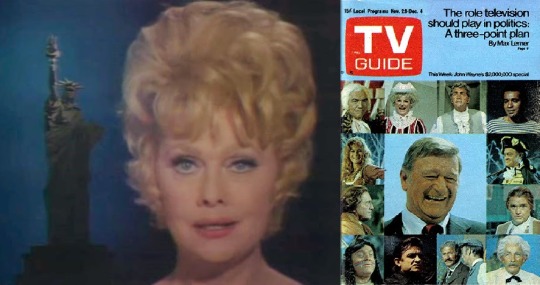
Lucy, Benny, Bob Hope, Dean Martin, George Burns, and Red Skelton, all appeared in the patriotic TV special “Swing Out, Sweet Land” which aired two weeks after this special on November 29, 1970.
THE SHOW
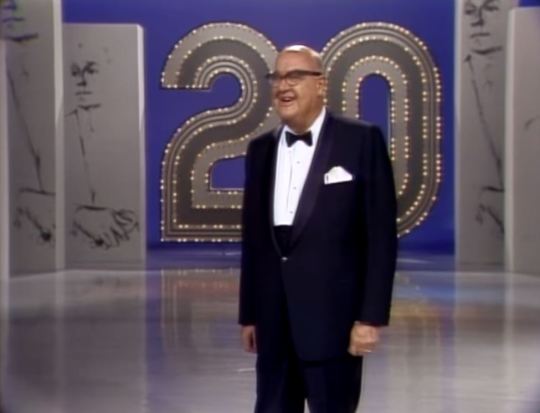
Announcer Don Wilson introduces Jack Benny, live on stage. He gets sidetracked saying how ungrateful Benny is. Jack watches from the wings and finally comes on stage to rebuke Wilson.
Benny: “You were just supposed to introduce me!” Wilson: “Introduce yourself!” (He walks off)
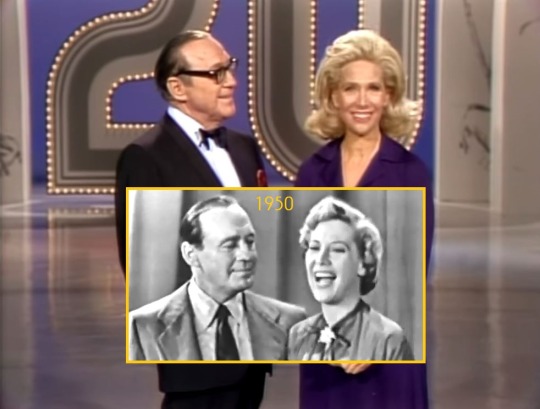
After a few opening remarks about his years on television and radio, Benny introduces Dinah Shore, who was also a guest on his very first TV show in 1950. They reminisce about that show. Dinah sings “All of a Sudden My Heart Sings” by Harold J. Rome, Henri Laurent Herpin, and Jean-Marie Blanvillain.

Dean Martin knocks on Jack's dressing room door to wish him a happy anniversary and dance “The Anniversary Waltz” with him. They sing and dance out the door. The bit lasts less than 30 seconds.
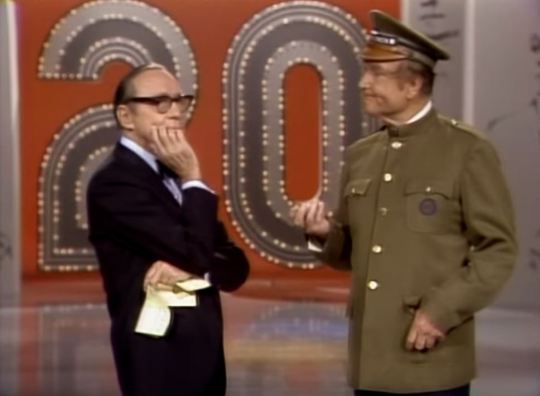
After a commercial message from Timex, Red Skelton skips on dressed as a Western Union messenger to give Jack Benny a telegram. He makes Benny laugh when he says “I'm a dreamer, aren't I?” while holding his hand out for a tip. He is on screen / stage for less than a minute.
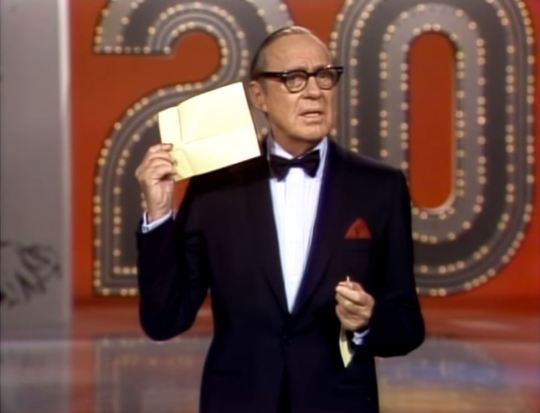
Skelton has delivered a talking telegram from George Burns, which instructs Jack to hold it up to his ear to hear the message.
Voice of George Burns: “Only an idiot would stand before 40 million people holding a telegram up to his ear.”
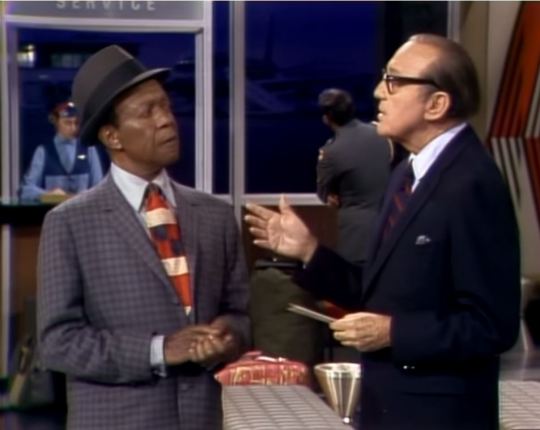
Benny has recruited Rochester to drive him to the airport for his trip to Mexico City.
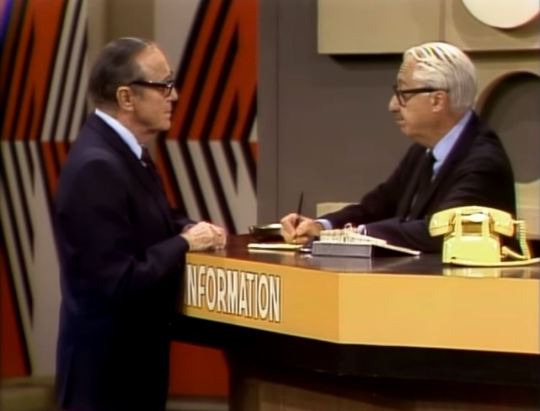
Wondering about the departure time, he asks at the information booth, manned by Benny Rubin. Whatever Benny asks him, his answer is “I dunno.”
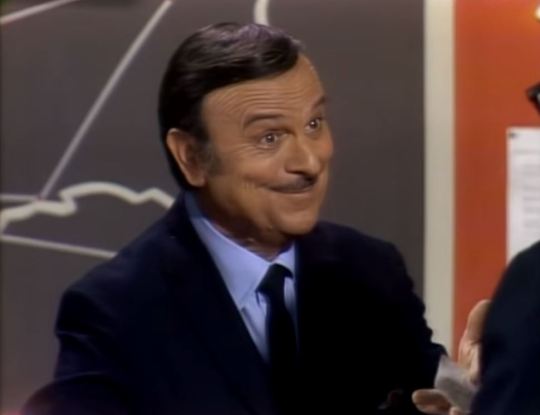
The ticket clerk is played by Frank Nelson, who greets him with his trademark “Yeeeeeeeeees?”
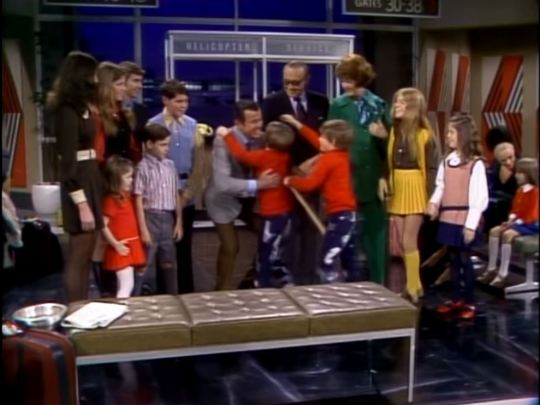
At the airport, Benny runs into Dennis Day, his wife Peggy, and their ten (!) children.

Rochester gives Benny's overweight luggage to a Mexican man (Mel Blanc) on the same flight.
In response to everything Benny asks, he says “si”. The man's name is “Sy”. He has a sister named “Sue.”
Blooper Alert! Despite this familiar old “si / Sy / Sue” routine, Benny mistakenly calls Rubin “Sue” then corrects himself saying “si” before Rubin chimes in “Sy”.
Benny hears hears a flight announcement that says his trip is delayed. Another voice comes on the public address system to say:

Voice (Mel Blanc): “Attention please. Attention! Plane leaving at gate five for Anaheim, Azusa, and Cucamonga!”
This is one of Mel Blanc's earliest routines from the Jack Benny radio show. Instead of a train station, here it is an airport.

Blanc's voice announces a flight for Alaska and three penguins come toddling toward the gate. These three penguins were also featured in “Jack Benny's Birthday Special” (February 17, 1969), which also starred Lucille Ball, Benny Rubin, Don Wilson, and Dennis Day.
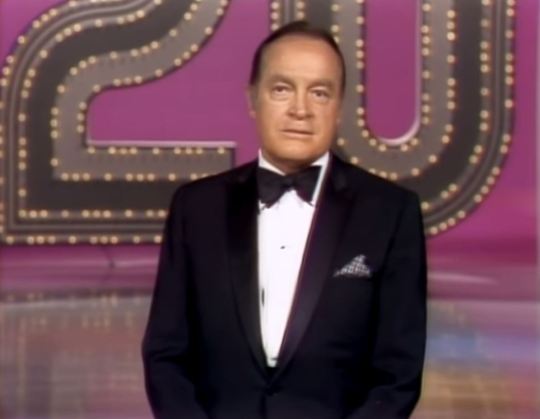
Bob Hope does a monologue about Jack Benny. Benny joins him onstage and Hope sings “Thanks for the Memory” (his theme song) with special lyrics about Benny's age. In response, Benny sings a few bars of “Love in Bloom” (his theme song) with special lyrics about Hope.
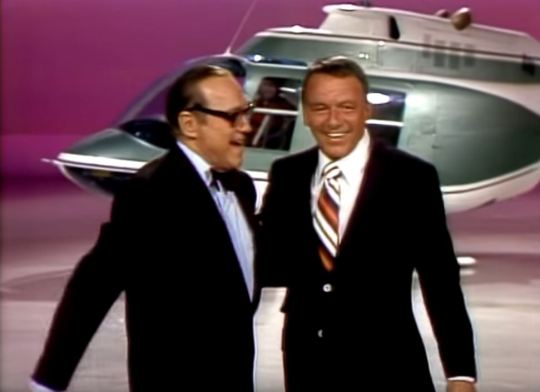
A helicopter lands in the studio and Frank Sinatra steps out of it! Frank invites Benny to go to the movies after the show. The double feature is The Kissing Bandit (1948) and The Horn Blows at Midnight. The Kissing Bandit is a film starring Sinatra that he loathed. The Horn Blows at Midnight is widely considered Benny's worst film. Sinatra sings “I Get A Kick Out of You” by Cole Porter. Sinatra substitutes the alternate lyric “Some like the perfume from Spain” instead of “Some get a kick from cocaine.” However, instead of following with “I'm sure that if I took even one sniff” he sings “I'm sure that if I took one look.”
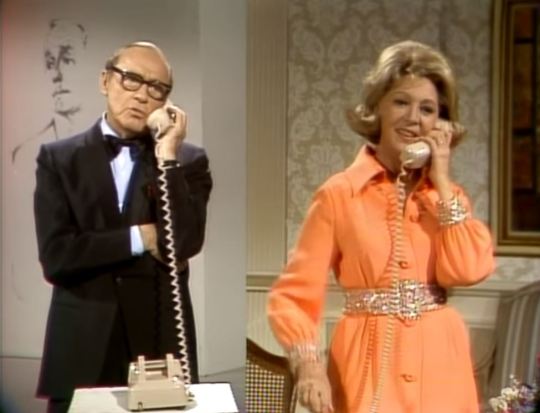
After a commercial, the scene is set in Jack Benny's home, where Mary Livingston picks up the telephone. It is Jack calling from the studio. He asks her to join him after the show for supper.
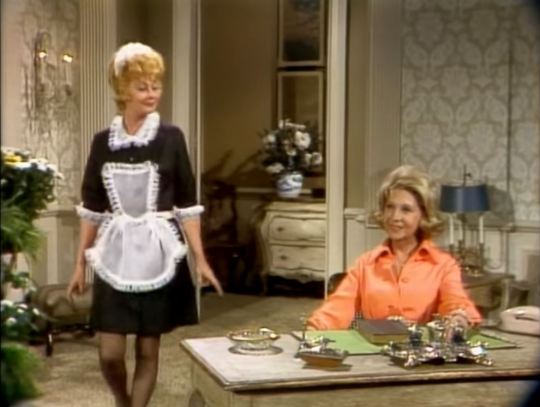
Mary calls her maid, Janet (Lucille Ball). Ball gets a huge round of applause from the studio audience.
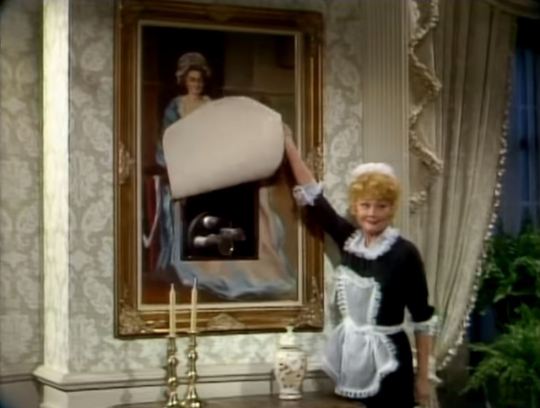
Janet reveals that Mary's been on TV the whole time because Jack has hidden a camera behind a painting of Betsy Ross!
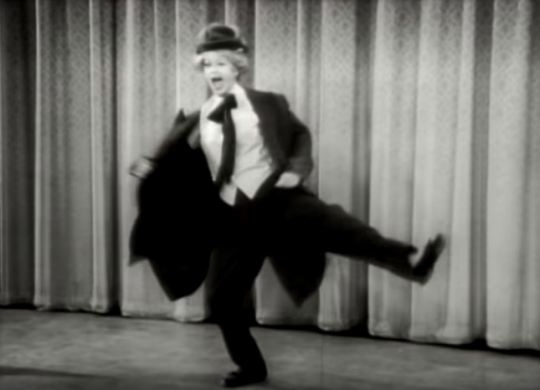
Back in the studio, Benny introduces film clips from his past 20 years. Stars include Jimmy Stewart, John Wayne, Marilyn Monroe, Ed Sullivan, Humphrey Bogart, Fred MacMurray, Kirk Douglas, Liberace, Tennessee Ernie Ford, Nat King Cole, Ginger Rogers, Charles Boyer, George Burns, Gracie Allen, Bob Hope, Bing Crosby, Milton Berle, Danny Thomas, Frank Sinatra, Lucille Ball, David Niven, Carol Burnett, Raymond Burr, Johnny Carson, Andy Williams, Rock Hudson, Dan Rowan, Dick Martin, Tom Smothers, Dick Smothers, Cary Grant, Billy Graham, Lawrence Welk, Dan Blocker, Robert Goulet, and Phyllis Diller.
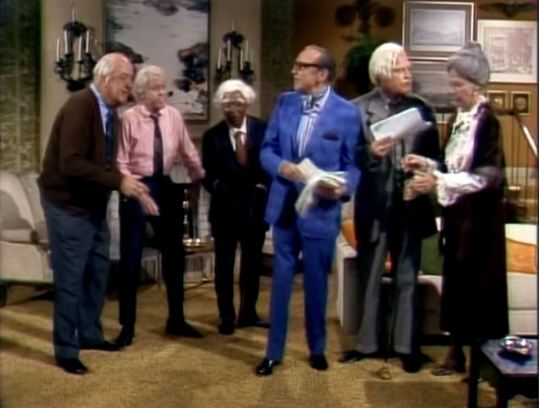
Jack Benny thinks ahead to what the next twenty years will bring. Flash forward to Rochester with white hair and a cane answering the door to a bald Don Wilson and a stooped over Dennis Day. A creaky Bob 'Road-To-Medicare' Hope joins them, supporting himself with a walking stick. A gray-haired Dinah Shore comes through the door and blows everyone one of her famous kisses “Mwaah!” The kiss sends her reeling across the room. Jack skips down the stairs energetically, not having age one iota since 1970 and distributes scripts to his ancient co-stars. Even though Jack Benny died in 1974, only four years after this special, he will forever be only 39 on TV.
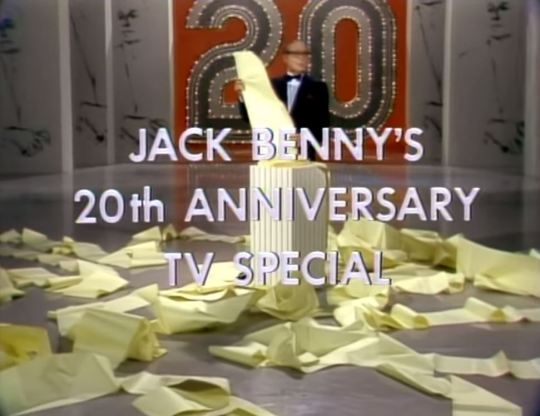
After the last commercial break, Jack takes a moment to thank his co-stars, and all of his viewers throughout the world. The camera pulls back to reveal an unfurled stack of computer printout and Benny starts reading the names of his viewers – alphabetically! “Mr. and Mrs. Tony Ames, Miss Terry Arco, Mr. and Mrs. Albert Aaron, Mrs. Andrew Aaronson...”
This Date in Lucy History – November 16th
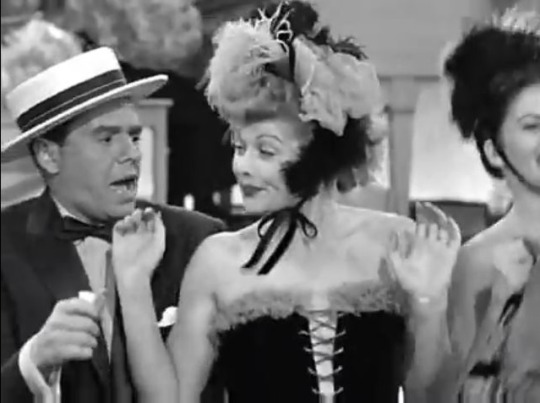
"The French Revue" (ILL S3;E7) – November 16, 1953
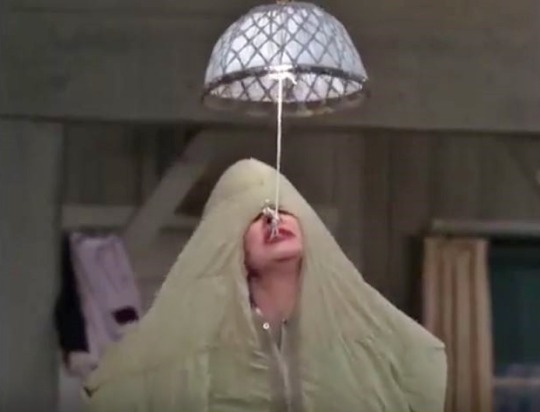
"Lucy Becomes a Father" (TLS S3;E9) – November 16, 1964
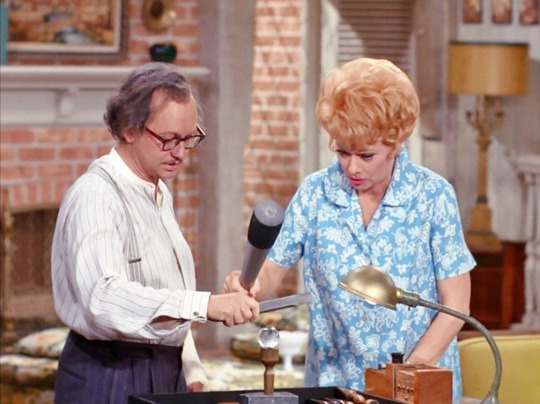
"Lucy the Diamond Cutter" (HL S3;E10) – November 16, 1970
#Jack Benny#Jack Benny's 20th Anniversary Show#Lucille Ball#Bob Hope#Dinah Shore#Hilliard Marks#Benny Rubin#Mel Blanc#Eddie Rochester Anderson#Mary Livingstone#George Burns#Don Wilson#Dennis Day#Frank Nelson#penguins#Peggy Almquist#Frank Sinatra#Dean Martin#Red Skelton#David Westberg#Timex#Love in Bloom#I Get A Kick Out of You#Helicopter#All Of A Sudden My Heart Sings#Thanks for the Memory#The Jack Benny Program#TV#1970#NBC
5 notes
·
View notes
Text
We unearth little-known tidbits of information about the King of Pop Michael Jackson’s life, on what would have been his 60th birthday
This slideshow requires JavaScript.
1. He was born in Gary, Indiana. He remains the city’s most famous resident, with Gary never recovering from the loss of its factory industry in the 1960s. That said, it’s also home to Jesse Powell, Kym Mazelle and Sista Monica Parker.
2. His parents had musical ambitions of their own. Mother Katherine Jackson played the clarinet and piano, and aspired to be a country and western singer. Father Joe was a guitarist and made extra cash performing in local R’n’B bands.
3. His first public performance was in 1963. When he was 5 he sang Shirley Bassey’s Climb Ev’ry Mountain at a public event organized by Garnett Elementary School’s Kindergarten.
4. His father was the first to notice the talent in his children. He would invite music executives to the family home, where The Jacksons would audition in the living room.
5. James Brown was his major inspiration. The late Godfather of Soul inspired Jackson to hit the stage. Speaking at his public funeral in 2007, Jackson recalled how, “Ever since I was a small child, no more than like 6 years old, my mother would wake me no matter what time it was, if I was sleeping, no matter what I was doing, to watch the television to see the master at work.”
6. He made his recording debut at 9 years old. It was on Big Boy by The Jackson 5, which was released by a small label in January 1968. It didn’t sell in large numbers, but it was enough to notify the major labels that these kids had talent.
7. His love for books began as a young teen. His early favorites were Rip Van Winkle by Washington Irving and The Old Man and the Sea by Ernest Hemingway. He reportedly amassed a library of more than 10,000 books.
8. His relationship with his sister La Toya was based on their love of practical jokes. His favorite was tormenting her with fake spiders and tarantulas. He would place a suspect creature on the phone in La Toya’s bedroom and would then call her and wait for her scream.
9. He began touring as an 8-year-old. As part of the first run of shows in America’s Midwest, The Jackson 5 supported soul legends Etta James, Gladys Knight and Sam & Dave.
10. He was never particularly fond of his voice during early recordings with The Jackson 5. Despite the acclaim, he would often lament the high pitch of his voice in later interviews, describing it as similar to that of Minnie Mouse.
11. It could have been The Jackson 6. Nearly 18 months before he was born, his mother gave birth to a set of twins, Marlon and Brandon. As a result of a severely premature pregnancy, Marlon survived but Brandon passed away 24 hours later.
12. Berry Gordy initially wasn’t a fan of Michael and his brothers. The star-maker and head of Motown Records dismissed the idea of signing them to his label, preferring to focus on Stevie Wonder. But he was eventually convinced to give them a shot and he signed them up in 1969.
13. You may not know her name, but Suzanne de Passe had a big role in his artistic development. She was assigned as a mentor and stylist to The Jackson 5 after they joined Motown. That relationship extended to Michael’s solo career, and she was the first one to see him rehearse the iconic dance The Moonwalk in 1983.
14. The Jackson 5’s global hit I Want You Back in 1969, was originally written for Gladys Knight and The Pips and Diana Ross. What’s unusual about the song is that the lovelorn lyrics are sung by Michael, who was barely in his teens at the time.
15. ABC is the first of Jackson’s songs that 50 Cent recalls hearing. Speaking to NME in 2015, the rapper said the track was responsible for him becoming a fan. “I’ve always loved MJ, so I guess it was probably a good place to start music: right here, with the ABCs.”
16. He broke barriers from a young age. When he was a 12-year-old with The Jackson 5, the group became the first black male group to release four back-to-back chart-toppers with 1969’s I Want You Back and 1970’s ABC, The Love You Save and I’ll Be There.
17. There was solo life before Off the Wall. For many, Michael arrived with 1979’s Off the Wall, but he released his debut solo album, Got to Be There, in 1972. It was a solid collection of soul and pop, with covers of Leon Ware’s I Wanna Be Where You Are and Bill Withers’s Ain’t no Sunshine.
18. He won his first and only Golden Globe in 1972. For Ben, a song he wrote for the 1972 horror film of the same name.
19. He always had his ear to the clubs. Jackson was a frequent visitor to the legendary New York City club Studio 54, where he was exposed to beat-boxing, which was an early harbinger to the upcoming hip-hop movement. He went on to incorporate the vocal technique into many of his future songs.
20. His first venture into film was The Wiz. He starred as a scarecrow in the title role of The Wiz, an adaptation of The Wizard of Oz. The film was horrible, but it was here he struck up a life-changing partnership with Quincy Jones, who went on to produce his biggest albums.
21. Quincy Jones nicknamed him “Smelly”. This was during their time on The Wiz. “I used to call Michael ‘Smelly’, because he wouldn’t say ‘funky’. He’d say ‘smelly jelly’.”
22. He broke his nose in 1979 during dance practice. He then consulted Hollywood favorite Dr Steven Hoefflin who reportedly performed Jackson’s first rhinoplasty.
23. He only worked with the best. In addition to enlisting Jones to produce the 1979 blockbuster album Off the Wall, the songwriters who helped him on the record included none other than Paul McCartney and Stevie Wonder.
24. Unlike many of his peers, Jackson hated singing from a sheet. While recording Off the Wall, he spent the evenings learning lyrics and harmonies, and would arrive at the studio the next day singing them off by heart.
25. Prince visited him during the Off the Wall sessions. Speaking to The National, Quincy Jones recalled how Prince arrived “into the studio like a deer in the headlight – clothes and shirt off – but he was always competing with Michael”.
26. He was the only musical mind behind one of his biggest hits. Off the Wall was full of songwriting collaborations, but Jackson was solely responsible for one of its biggest tracks, Don’t Stop ’Til You Get Enough. He decided to write the song after constantly humming the melody at home.
27. The change on 1979 single Rock with You. It was originally called I Want to Eat You Up, but that was deemed too risque for Jackson’s heartthrob image.
28. Off the Wall was almost a hit for Karen Carpenter. The hit title track from Off the Wall was originally written for the late Karen Carpenter’s debut solo album. She declined to use it and Jackson made it a top 10 hit instead.
29. The tears in She’s Out of My Life are real. Jackson would break down in tears at the end of each studio take. “We recorded about – I don’t know – 8 to 11 takes, and every one at the end, he just cried,” producer Quincy Jones said. “I said, ‘Hey – that’s supposed to be, leave it on there.’”
30. Jackson surrounded himself with talent in both the studio and the boardroom. With Off the Wall he secured the game-changing royalty rate of 37 cents wholesale per sale. It went on to sell more than 20 million copies.
31. Thriller was a blockbuster fueled by frustration. Despite big sales and critical acclaim, he was irked that Off The Wall didn’t win the Grammy Award for Record of the Year. “It was totally unfair that it didn’t get Record of the Year and it can never happen again,” he told manager John Branca. Thriller went on to win a record-breaking eight Grammys in 1984.
32. Billie Jean doesn’t exist. Despite being the subject of one of his biggest hits, the woman – who in the 1983 song admits she is carrying Jackson’s unborn son – is pure fiction. “The girl in the song is a composite of people my brothers have been plagued with over the years,” Jackson wrote in his memoir Moonwalker.
33. Billie Jean was the first video by an African-American artist to air on MTV. The video revealed Jackson’s new look of a leather suit, pink shirt, red bow tie and his signature single white glove. It was a style copied by kids throughout the United States. It caused one school, New Jersey’s Bound Brook High, to ban students from coming to class wearing white gloves.
34. Jackson introduced his famous Moonwalk in 1983. It was during a live performance of Billie Jean for the Motown 25: Yesterday, Today, Forever concert special. He was taught the move by veteran dancer Jeffrey Daniel, who went on to be hired as Jackson’s co-choreographer.
35. Jackson was a music investor from 1983. He bought the rights to select music from funk pioneers Sly and the Family Stone, and the iconic Dion DiMucci songs The Wanderer and Run Around Sue, before landing the rights to the 4,000 song catalogue of ATV Music Publishing, which included the lion’s share of The Beatles’ songs.
36. Jackson’s Beat It was a fiery single … literally. When Eddie Van Halen recorded his blistering solo, the sound of his guitar caused one of the studio speakers to catch fire.
37. The gritty music video for Beat It was a landmark production. The lavish production cost US$100,000 (Dh367,250) at the time. It was set in Los Angeles’ Skid Row and featured up to 80 real-life gang members from the notorious street gangs the Crips and the Bloods.
38. Toto were heavily involved in the making of Thriller. Keyboardist Steve Porcaro co-wrote Human Nature, and Steve Lukather contributed rhythm guitar on Beat It.
39. Thriller was almost Star Light. The lyric “thriller” in the track of the same name was originally “star light”. The decision to change it was down to marketing appeal.
40. PYT (Pretty Young Thing) was never performed live by Jackson. Despite being a well-received single from the Thriller album, the star never featured the song in any of his live sets.
41. Thriller was included in the Library of Congress’ National Recording Registry. The music video for the title track was also placed in the National Film Preservation Board’s National Film Registry of “culturally, historically or aesthetically significant films”.
42. It was with his seventh album, 1987’s Bad that Jackson really came into his own as a songwriter. He wrote nine of the 11 tracks and co-produced the album with Quincy Jones.
43. The title track for the Bad album was supposed to be a duet with Prince. But the latter walked away from it due to the opening line “Your butt is mine”. “Now, who is going to sing that to whom? Cause [he] sure ain’t singing that to me, and I sure ain’t singing it to [him],” Prince said in a TV interview with American comedian Chris Rock.
44. The smooth 1987 ballad I Just Can’t Stop Loving You is a duet with singer Siedah Garrett. She was the third choice after Barbra Streisand and Whitney Houston rejected the offer.
45. The Way You Make Me Feel was his mother’s request. Jackson wrote this track after his mum asked him to write something with a “shuffling kind of rhythm”.
46. Man in the Mirror is one of the few music videos he is hardly in. Other than appearing at the end standing in a crowd, the video is a montage of major events and historical figures.
47. His Superbowl XXVII half-time show in 1993 was game-changing. His pyrotechnics-laced four-song set was watched more than the game itself. It has set the standard for half-time shows ever since.
48. Michael Jackson’s 1991 album Dangerous was hot property. Five days before its release, three armed men broke into a music warehouse in Los Angeles and stole 30,000 copies.
49. The explosive video for Black or White was directed by Hollywood stalwart John Landis. It starred an 11-year-old Macaulay Culkin fresh from his starring role in Home Alone.
50. The music video to Scream was, at the time, in 1995, the most expensive ever produced. It had a US$7m budget. The menacing and arty video starred Jackson and his sister Janet.
51. Even when he wasn’t trying, Michael Jackson broke records. His album Blood on the Dance Floor: HIStory in the Mix, released in 1997, remains the bestselling remix album of all time, with more than six million copies sold, after virtually no promotion.
52. Jackson consistently mixed music with charity work. He was behind a series of Michael and Friends concerts in Germany and Korea, which featured performers such as tenors Luciano Pavarotti and Andrea Bocelli, as well as rockers Slash and The Scorpions. The money raised went to the non-profit organization War Child.
53. Jackson’s final studio album Invincible was the bestselling album of 2001, despite moderate reviews. It features the song Unbreakable, which had, until then, the unreleased vocals by slain rapper The Notorious BIG.
54. After years of scandals and court cases, Jackson re-emerged on the music stage by announcing his final live tour This Is It. The first 10 shows alone, to be held at London’s O2 Arena in the summer of 2009, would have netted him £50m (Dh236.49m). The residency was extended to 50 shows, but the tour was cancelled following his death on June 25, 2009.
55. This Is It was his first posthumous release. With the This Is It tour abandoned after Jackson’s death, the tour’s title track became the first of many posthumous releases. The song was originally written in the 1980s by Paul Anka.
56. The secrecy of Xscape. Michael Jackson’s second posthumous album, released on May 13, 2014, was such a big deal that journalists were invited to secret listening sessions around the world days before its release. The session for this region was held at Dubai’s now-closed Qbara restaurant.
57. The life and times of Michael Jackson were discussed in detail at the inaugural Dubai Music Week in 2013. It featured a sold-out special panel session on Jackson’s career featuring producer Quincy Jones and other collaborators, the late Rod Temperton (via live video feed) and singer Siedah Garrett.
58. Abu Dhabi and China were discussed as possible sites for the world’s first Jackson family-themed hotel called Jermajesty. Speaking exclusively to The National in 2013, Jermaine Jackson said he was looking at Yas Island as a possible site for the hotel, which would be filled with Jackson family memorabilia. Nothing has been built as yet.
Read also: Jermaine says Michael Jackson was on the verge of converting to Islam
59. To celebrate Michael Jackson’s 60th birthday today (August 29), a large street party was held in New York City last Saturday to celebrate his life. It was organized by the director, and his collaborator, Spike Lee.
60. It is only fitting that the Apollo Theater in New York is hosting its legendary Amateur Night today. It was on the same stage that, in 1967, The Jackson 5 launched their career.
60 Things You May Not Have Known About Michael Jackson
2 notes
·
View notes
Text
Dancing With The Stars Week 8 Results : Who Went House On Dwts Period 9?
Mya and Dmitry Chaplin eased into the energetic jitterbug with a prolonged introduction. Taking part in the component of a maid and a janitor, respectively, it took the couple awhile to get into the routine. As soon as they did, there were tons of clips, a handful of claps and plenty of head bops to go about. The singer, who started off the season as a star performer, felt a small bit secure, even during Dmitry's lifts. news is alive and nicely. Twitter was complete of messages on Thursday stating that the singer had passed away. Carter took to his official Twitter account this morning to report that rumors of his death are untrue.
youtube
Kelly Osbourne and Louis van Amstel experienced a large obstacle to conquer this week: Kelly. Her insecurities, which have plagued her all period, arrived back again in rehearsals for the jitterbug. Despite her adorable sequined gown, the schedule lacked spunk and the type of wild abandon brought by mark. Kelly went via the motions with some achievement but her facial expressions swung from a large smile to a serious pout. The tabloid favorite will have to rely on her fans to have her through.
Popstar Aaron Carter
Today's Dancing with the Stars 2009 Season 9 announcement on Great Morning America introduced the nation to its latest dancing icons. Some new cast associates seem obvious, some are out of the blue - and one in specific is a little bit of a shock.

When I was four many years previous, I really begged my father for a guitar. He was like, "No, you can't have 1 till you're five." So, eventually, when I was 5, he gave me a guitar, and ever since, I by no means want to put the guitar down. That's truly where it all started. Grammy Winning singer/songwriter Joss Stone took to the stage with her single Free Me when the Dancing with the Stars outcomes display ongoing. I don't know about you, but when I look at Joss Stone and her fairly encounter and girly hair, and then listen to her sing, I'm usually shocked by the cacophony in between the sight and the sound. Her voice is lovely, I believe, but just not what I ever anticipate. Anyway, she was joined by a pair of professional dancers doing their thang on the ballroom floor. It looked like an elaborate bedroom dance, if you want my viewpoint.
Aaron Carter Boyfriend
What it comes down to is who has the bigger enthusiast foundation watching "Dancing with the Stars" and voting? Snowboarders who assistance Vito? Soccer followers who support Irvin? Swimmers who support Coughlin? Coughlin is a California woman, born and elevated in this state. She attended UCBerkeley. The second Dancing with the Stars outcomes display of the 9th period aired this night on ABC. The display sooner or later lyrics aaron carter featured co-host Samantha Harris doing her best impression of Morticia Addams-crossed-with-a-chia-pet, performances by the USC Trojan marching band and singer Joss Stone, critiques of final night's action, and of course, the all-important elimination of a third celeb from DWTS period 9. For the night's play-by-play as seen through my rose and green and yellow and generally paint and peanut butter smeared mommy-goggles, read on. The first group to perform was Team Paso, consisting of, Mark Dacascos, websites, Mya and Michael Irving, alongside with their Dancing with the Stars professional companions. The judges praised Team Tango and scored every 24 factors.
youtube
Aaron Carter That'S How I Beat Shaq
The initial outcomes show will air on Wednesday, September 23rd and will feature a Patrick Swayze tribute, a performance by Sean Kingston, award-winning Lion King dancers and the first Macy's "Stars of Dance" performance of the season. Melissa Joan Hart - Melissa continues to enhance with every week, and her expert dancing companion Mark Ballas carries on to push her in workouts. Unless of course she has a complete catastrophe, do not look for her to go house in 7 days four.

Aaron Carter Hiv
Ashley Hamilton and Edyta Silwinska. Ashley Hamilton is a singer, songwriter and comedian, and son of George Hamilton, who was a prior DWTS competitor. His companion Edyta Sliwinska is the only dancer to appear on all eight seasons of DWTS. Her previous companions include: Lawrence Taylor, Jeff Ross, Jason Taylor, Cameron Mathison, John Ratzenberger, Vincent Pastore, Joey Lawrence, George Hamilton and Evander Holyfield. Her husband is fellow dancer Alec Mazo. With no prior dance encounter, Ashley's opportunity of successful it all is uncertain, but if anybody can whip him into shape, it's Edyta. Furthermore, isn't it time she took house the mirror ball trophy? Grammy Winning singer/songwriter Joss Stone took to the stage with her single Totally free Me when the Dancing with the Stars outcomes display continued. I don't know about you, but when I look at Joss Stone and her pretty face and girly hair, and then hear her sing, I'm always stunned by the cacophony in between the sight and the sound. Her voice is beautiful, I think, but just not what I at any time expect. In any case, she was joined by a pair of pro dancers doing their thang on the ballroom floor. It looked like an elaborate bedroom dance, if you want my opinion. Dancing with the Stars the Results Show will air tonight, eleven/03/2009, on ABC at 8:00 Central time. Tune in to discover out who will be voted off on the double elimination spherical and which two contestants will have the most affordable scores, consequently competing in a dance off, exactly where the Dancing with the Stars judges will determine their destiny.
0 notes
Text
2009 Dancing With The Stars Week Three: Mya Earns Initial 10S (Video Clip)
Donny Osmond is an entertainer and he's made this period extremely entertaining--on and off stage. The kiss with decide Bruno Tonioli was shock that Tonioli and Osmond carry on to perform on. However Osmond is a competitor and he took the criticism to coronary heart, creating sure his moves were sharp. Last evening, during his Argentine tango, it payed off. He scored a 29--two tens and a nine (from Len Goodman). The first team to carry out was Group Paso, consisting of, Mark Dacascos, he said, Mya and Michael Irving, along with their Dancing with the Stars expert partners. The judges praised Group Tango and scored each 24 factors.
youtube
Snowboarder Louie's smile on the dance floor looked like the ultimate illustration of deer in headlights: he danced like a truck was about to hit him. Louie got some fairly hefty praise from the judges, even if he did get known as a "little dancing hobbit" by Bruno. I guess Louie can dance all the way to The Shire with a rating of 19, and with a extremely great impact on the team salsa.
Aaron Carter Albums
Co-hosts Tom Bergeron and Samantha opened the hour of the first Dancing with the Stars drop 2009 outcomes display by turning to head judge Len Goodman and requesting the judges' pick for the encore dance. Final evening's shock sleek swan of the ballroom Kelly Osbourne and Louie van Amstel delighted the group with their Viennese Waltz as soon as again. I'm still so impressed with Kelly. I had, fairly actually, nearly no expectations for Kelly Osbourne on DWTS season nine. I thought she'd suck and I felt badly for poor Louie. But she's incredible and was amazing however once more tonight.

Michael Irvin and Anna Demidova. Michael Irvin gained 3 Tremendous Bowl rings whilst playing for the Dallas Cowboys. In 2007, Irvin was inducted into the Expert Football Corridor of Fame. He presently hosts his own radio display in Dallas for ESPN Radio. His companion Anna Demidova produced her DWTS debut in the celeb round of the Season eight pro-dancer competitors. She gained and clinched her place as a Period 9 professional. She is also a three-time expert dancing winner. With Irvin's appeal and athleticism and Anna's 1st yr enthusiasm, this may be 1 few to set the dance floor on fire. Judge verdict: Len said, "Sometimes less is more-but not in the jitterbug. More is more." Carrie Ann whooped it up and said she was thrilled. All three dinged him for a misstep in the direction of the finish.
Aaron Carter Skinny
So that's that! Kathy Eire went home at the close of Dancing with the Stars week two results show. Be sure to tune in next 7 days for much more DWTS period 9 motion! Or you can just check in with me. You know I'll be watching. There has been much speculation and numerous media reports surrounding alleged quotes from singer Aaron Carter on the famous King of Pop, Michael Jackson. When a reported interview made headlines more than alleged estimates from Carter, the singer quickly denied that he had at any time said any of the things that he was being quoted as stating. In accordance to a new update produced by the singer by way of Twitter, Aaron Carter will reportedly be highlighted on E! News these days in an job interview in which he will be discussing the Michael Jackson story. Three women and one man stay as we go into the semi-finals of Dancing with the Stars Period nine. Kelly Osbourne defeat out go to this web-site final week showing that getting followers may be much more important than getting skills in this competitors. Every couple would carry out three dances, such as a "knock-out" dance that is meant to wow the judges and the viewers.
youtube
Aaron Carter Dancing With The Stars
Yes, Miley Cyrus' newest video was premiered next, but I'm disregarding it. I'm not happy with her. Disney and pole dancing don't belong in the same sentence, states this mama. So that's what occurred on Dancing with the Stars; another week of competitors is in the books. I was impressed in a 'wow, I'm surprised' way with Louie Vito, Donny Osmond and Natalie Coughlin. I was impressed in a 'will of steel' way with Tom Delay. I was happy to see Kelly Osbourne stage it back up once more. So who goes home? Mercy states it ought to be the hurt Tom Delay, who might well not be in a position to dance next week in any case. But I'll say Debi Mazar, just because she was in the base two last 7 days. Now I admit that goes towards my typical concept that instant survivors of the bottom two will be is aaron carter gay the beneficiary of additional votes the 7 days following their bottom two-ness, but I don't treatment. That's my prediction.

Aaron Carter Albums
Natalie Coughlin and Alec Mazo. The charming Olympic swimming gold medalist is the most decorated athlete of both the 2008 Bejing and 2004 Athens games. Her companion Alec Mazzo was the professional winner when he partnered with Kelly Monaco in Period 1. His prior celeb companions include Toni Braxton, Josie Maran, Paulina Porizkova and Kelly Monaco. With Natalie's athleticism and Alec's experience, this team ought to go much in the competitors. Grammy Winning singer/songwriter Joss Stone took to the phase with her single Free Me when the Dancing with the Stars results display continued. I don't know about you, but when I look at Joss Stone and her fairly encounter and girly hair, and then hear her sing, I'm always stunned by the cacophony in between the sight and the audio. Her voice is lovely, I think, but just not what I ever expect. Anyway, she was joined by a pair of professional dancers performing their thang on the ballroom flooring. It looked like an elaborate bedroom dance, if you want my viewpoint. Bruno said, "It was like watching a little dancing hobbit." He noted that Vito lacked fluidity and fell two times. From there Bergeron labeled Vito: Louie Frodo.
0 notes
Text
Dancing With The Stars 2009 Cast: Very Best Of The Jitterbug (Video Clip)
The season 9 finale is only two months away and anticipation is developing. Only 5 stars remain - Aaron Carter, Donny Osmond, Joanna Krupa, Kelly Osbourne and Mya - all for a mirror ball trophy. View them encounter some of the toughest dances yet, and make certain you cast your vote after tonight's display. The initial team to perform was Team Paso, consisting of, Mark Dacascos, he has a good point, Mya and Michael Irving, alongside with their Dancing with the Stars expert partners. The judges praised Team Tango and scored every 24 factors.
youtube
I'd by no means truly noticed much of Mark outside of "Iron Chef," and he was actually a fairly enjoyable man to view. He may have experienced the cheesiest presentation of anybody I've seen to begin the display, but he could move pretty nicely. The biggest issue for him will be staying targeted on the dance. Tonight's secret component is.dancing! (Alright, only kidding.) Mark ended up with a 21 and a second-place finish in the team waltz.
Aaron Carter Candy
Macy Gray. Sweet mercy that voice is back again. Let's hope for an early exit, or for her to put on one of these attire marketing her new album like she did on MTV's VMAs that one year.
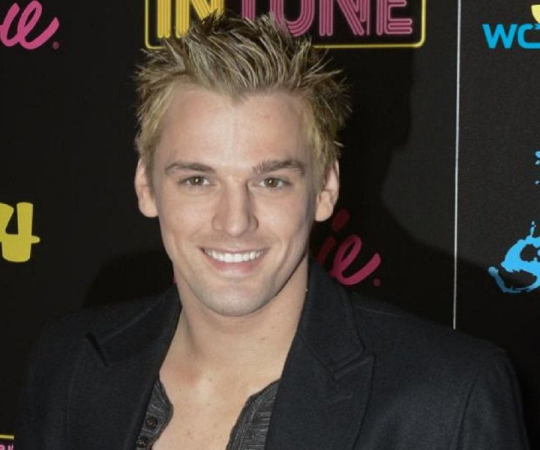
Dancing with the Stars Fall 2009's 3rd week of competitive dancing, considered "the sexiest night of the period" by co-host Tom Bergeron, opened with a quick evaluation of last 7 days's action, and ongoing on with the typical introduction of the DWTS period 9 stars. We rapidly learned that the thirteen remaining celebs and their professional partners would be performing one of two dances: The Samba or the Rumba. We THEN discovered that previous House Vast majority Leader Tom Hold off's pre-tension fracture experienced progressed into a full tension fracture; so would he compete? Tom and co-host Samantha Harris left it a big DWTS season 9 7 days 3 unknown for now. How annoying. It's not as if I'd turn off the Television if Tom Delay and Cheryl Burke finished their tenure on the show. NFL star Michael Irvin and partner Anna Demidova were next up on DWTS with their Samba. Michael's really had a hard time with the judging panels this period. The thing I value about Michael is his performer's heart: He appears to have fun each week, even when he's nailed by Len, Carrie Ann and Bruno. That said, it thought their Samba lacked a little. It appeared sluggish and just not exactly what I'm utilized to seeing for the style of dance. Bruno stated "sometimes you danced this like a tank" and proceeded to defeat him down. Ouch. Carrie Ann stated "I definitely believe you have rhythm but you're dancing too small". Len said "it's a hard dance for a big man" and "I'm afraid it was a bit disappointing". Oof. Michael Irvin and Anna Demidova's Dancing with the Stars Drop 2009 week three scores: 5, 4, 5 = fourteen.
Aaron Carter Come Get It
Age has not been kind to the 68 year previous music producer. Phil Spector -- who can name John Lennon, the Righteous Brothers, Leonard Cohen, and George Harrison among songs's greats associated with him - was lastly convicted of 2nd diploma murder in the loss of life of Lana Clarkson. His reserving photo - the now famed Phil Spector mug shot found on the Smoking Gun - provides increase to speculation that fairly much any sentence handed down on Might 29 will be a lifestyle sentence. Insanity workout is the new revolution for house fitness created by Shaun T. And this is a real reality, because numerous people have seen genuine outcomes in just 60 times, without becoming forced to go to fitness centers or to take diet plan pills. This plan is a new brand established of workouts that altered individuals's lives. Now, I wager you ask yourself who is this Shaun T and why you should take into thought his program? While check my reference might be well known to the younger group, his "look at me" arrogant attitude has obviously not played well with older DWTS' viewers. He retains landing in the bottom two despite his superb method and dancing ability.
youtube
Nick And Aaron Carter
I'd by no means truly seen a lot of Mark outside of "Iron Chef," and he was really a pretty fun man to watch. He might have had the cheesiest presentation of anybody I've seen to start the display, but he could move pretty nicely. The biggest problem for him will be staying focused on the dance. Tonight's magic formula component is.dancing! (Okay, only kidding.) Mark finished up with a 21 and a 2nd-place end in the team waltz. "The Addams Family members" theme song created by Vic Mizzy. Even though The Addams Family only aired from 1964-1966, its theme tune remains massively recognizable.

Aaron Carter Wiki
When I was four years previous, I really aaron carter and hilary duff begged my father for a guitar. He was like, "No, you can't have one until you're 5." So, ultimately, when I was 5, he gave me a guitar, and at any time since, I by no means want to put the guitar down. That's really exactly where it all began. For Dancing with the Stars Season nine, issues will be carried out a small different in mid-season, according to host Tom Bergeron. 3 double eliminations will be held back again-to-back at that time, whilst dances like the Charleston, the Lambada, the Two Stage and the Bolero are worked into the rotation. Ashley Hamilton was pleased to be there he said, son of George Hamilton and just trying to adhere to in his father's footsteps. Companion Edyta Sliwinska wore an outfit that was very complementary and both looked dapper on the flooring, but Ashley also seemed extremely rigid. Total score of 19.
0 notes
Text
Dancing With The Stars Outcomes Display Season Nine 7 Days Seven
Dancing With the Stars fans are psyched about the big Season nine premiere. In the meantime, here's a opportunity to get acquainted with the partners, weigh their chances for success, and catch up on the very newest DWTS news. Strap in simply because this looks to be a bumpy, however thrilling period! check over here is alive and nicely. Twitter was complete of messages on Thursday stating that the singer had handed absent. Carter took to his official Twitter account this morning to report that rumors of his loss of life are false.
youtube
Karina Smirnoff is always a pleasure to view on the dance floor. There is no denying that she aaron carter arrested is 1 of the very best pros in the bunch. However, placing up with the daggers she throws the judges and the audience when things don't go her way is just as well much to inquire.
Aaron Carter Young
Q: You know its funny that you say you have zero dance encounter, just recently Debbie Mazar stated that you and Natalie Coughlin are going to be her toughest competition. What believe about that?

Ashley Hamilton and Edyta Silwinska. Ashley Hamilton is a singer, songwriter and comedian, and son of George Hamilton, who was a previous DWTS competitor. His partner Edyta Sliwinska is the only dancer to appear on all 8 seasons of DWTS. Her previous companions consist of: Lawrence Taylor, Jeff Ross, Jason Taylor, Cameron Mathison, John Ratzenberger, Vincent Pastore, Joey Lawrence, George Hamilton and Evander Holyfield. Her spouse is fellow dancer Alec Mazo. With no prior dance experience, Ashley's opportunity of successful it all is doubtful, but if anyone can whip him into shape, it's Edyta. Furthermore, isn't it time she took house the mirror ball trophy? Michael Irving obtained a 23, which was the subsequent lowest rating to be dished out by the Dancing with the Stars judges. Michael has enhanced considerably in the last two weeks. Will Michael's improvement maintain him out of tonights Dancing with the Stars double elimination round? Will Michael obtain enough votes from the fans at house to keep him out of the dance off?
Aaron Carter Today
This is my plea to the producers to get their act back together and give the audience what they want - - fun, drama, intrigue, comedy - - and, of course, fantastic dancing. Deny us what we want and we will gladly catch "So You Believe You Can Dance" rather. It never disappoints. The ninth season of Dancing with the Stars aired last night and it is bigger than ever (actually). With 16 contestants, the producers the initial week's competition into two components: the men and the women. First up: the men. Tom Bergeron rehashed final night's action and current judges' standings. And then. the males's component of tonight's DWTS 7 days 1 season 9 elimination began: Louie Vito and partner Chelsie Hightower and find more and companion Karina Smirnoff were proclaimed secure to dance once more. I'm not really shocked; they're both cute young thangs, after all.
youtube
Aaron Carter Wiki
Apple co-founder Steve Wozniak, who did his very best to collect votes via a Fb assistance team web page during Period 8, unsuccessful to exploit the immediacy of Twitter. So that's what occurred on Dancing with the Stars; an additional 7 days of competitors is in the books. I was amazed in a 'wow, I'm shocked' way with Louie Vito, Donny Osmond and Natalie Coughlin. I was impressed in a 'will of metal' way with Tom Delay. I was happy to see Kelly Osbourne stage it back again up once more. So who goes home? Mercy states it should be the hurt Tom Delay, who may nicely not be in a position to dance next week in any case. But I'll say Debi Mazar, just because she was in the bottom two final week. Now I admit that goes towards my usual concept that immediate survivors of the base two will be the beneficiary of extra votes the week following their base two-ness, but I don't treatment. That's my prediction.

Aaron Carter Shirtless
Michael Irvin and Anna Demidova. Michael Irvin gained three Tremendous Bowl rings while playing for the Dallas Cowboys. In 2007, Irvin was inducted into the Expert Soccer Hall of Fame. He currently hosts his own radio display in Dallas for ESPN Radio. His partner Anna Demidova produced her DWTS debut in the celeb spherical of the Period eight pro-dancer competitors. She gained and clinched her location as a Period nine expert. She is also a three-time professional dancing champion. With Irvin's appeal and athleticism and Anna's 1st yr enthusiasm, this may be 1 couple to established the dance flooring on fire. "Ghostbusters" by Ray Parker, Jr. The theme song to the well-liked movie strike #1 in 1984 and stayed there for three months. It's still a well-liked song for Halloween festivities and events. Bruno said, "It was like viewing a small dancing hobbit." He mentioned that Vito lacked fluidity and fell two times. From there Bergeron labeled Vito: Louie Frodo.
0 notes
Text
Sylvia Robinson







Sylvia Robinson (née Vanderpool; March 6, 1935 – September 29, 2011) was an American singer, musician, record producer, and record label executive. Robinson was best known for her work as founder/CEO of the hip hop label Sugar Hill Records. Robinson is credited as the driving force behind two landmark singles in the genre; "Rapper's Delight" (1979) by the Sugarhill Gang, and "The Message" (1982) by Grandmaster Flash and the Furious Five; which dubbed her as the "Mother of Hip-Hop". Robinson received a Pioneer Award for her career in singing and being the founder of Sugarhill Records at the 11th Annual Rhythm and Blues Awards Gala in 2000. Robinson died of congestive heart failure on September 29, 2011 at age 76.
Biography
Robinson was born as Sylvia Vanderpool (aka Vanterpool) in 1935 in New York City. Robinson attended Washington Irving High School until the age of 14, and began recording music in 1950 for Columbia Records under the billing, Little Sylvia.
Early Career
In 1954, she began teaming up with Kentucky guitarist Mickey Baker, who then taught her how to play guitar. In 1956, the duo now known as Mickey & Sylvia, recorded the Bo Diddley and Jody Williams-penned rock single, "Love Is Strange," which topped the R&B charts and reached number eleven on the Billboard pop charts in early 1957. After several more releases including the modestly successful "There Oughta Be a Law", Mickey & Sylvia split up in 1959 with Sylvia later marrying Joe Robinson that same year. Sylvia restarted her solo career shortly after her initial split from Baker, first under the name Sylvia Robbins. In 1961, the duo reunited and recorded more songs together for various labels. They are most noted during this period for singing background on Ike & Tina Turner's hit single, "It's Gonna Work Out Fine". In 1964, frustrated with the music business, Baker moved to Paris.
In 1966, the Robinsons moved to New Jersey where they formed a soul music label, All Platinum Records, the following year, with artist Lezli Valentine, formerly of the Jaynettes, bringing the label its first hit with "I Won't Do Anything". In 1968, the duo signed a Washington, D.C. act named The Moments, who immediately found success with "Not on the Outside". Within a couple of years and with a new lineup, the group scored their biggest hit with "Love on a Two-Way Street", which Sylvia co-wrote and produced with Bert Keyes and (uncredited) lyrics by Lezli Valentine. Other hits on the label and its subsidiaries, including Stang and Vibration, included Shirley & Company's "Shame, Shame, Shame", the Moments' "Sexy Mama" and "Look at Me I'm in Love" and the Whatnauts/Moments collaboration, "Girls". Robinson co-wrote and produced many of the tracks, although later she was supported by members of The Moments, Al Goodman and Harry Ray, as well as locally based producers, George Kerr and Nate Edmonds.
Solo Career
In 1972, Robinson sent a demo of a song she had written called "Pillow Talk" to Al Green. When Green passed on it due to his religious beliefs, Robinson decided to record it herself, returning to her own musical career. Billed simply as Sylvia, the record became a major hit, reaching number-one on the R&B chart and crossing over to reach Billboard Hot 100 (#3), while also reaching #14 in the UK at the beginning of 1973. She was awarded a gold disc by the R.I.A.A. in May 1973. Robinson recorded four solo albums on the Vibration subsidiary and had other R&B hits including "Sweet Stuff" and "Pussy Cat". "Pillow Talk" has been called an early example of prototypical disco music and went on to sell two million copies. The vocals are replete with moaning and heavy breathing, predating Donna Summer's orgasmic moans on "Love to Love You Baby".
Sugarhill Records
In the 1970s, the Robinsons founded Sugar Hill Records. The company was named after the culturally rich Sugar Hill area of Harlem, an affluent African American neighborhood in Manhattan, New York City, known as a hub for artists and performers in the early and mid-1900s. The song "Rapper's Delight", performed by The Sugar Hill Gang, brought rap into the public music arena and revolutionized the music industry by introducing the technique of re-using existing compositions, a practice that became known as "sampling". Later acts signed to Sugar Hill Records included all-female rap/funk group The Sequence, featuring a teenage Angie Stone (recording as "Angie B"), who had a million-selling hit in early 1980 with "Funk U Up". Sugar Hill folded in 1985, due to changes in the music industry, the competition of other hip-hop labels, such as Profile and Def Jam and also financial pressures. Robinson, who had by now divorced Joe Robinson, continued her efforts as a music executive, forming Bon Ami Records in 1987. The label was noted for signing the act The New Style, who later left and found success as Naughty by Nature.
Death and future biopic
Robinson died on the morning of September 29, 2011, aged 76, at Meadowlands Hospital in Secaucus, New Jersey from congestive heart failure. On August 19, 2014, The Hollywood Reporter reported that producer Paula Wagner had acquired the rights to the life story of Sylvia Robinson, the influential rap pioneer and producer known as the "Mother of Hip-Hop." Wagner acquired the rights from Robinson's son, Joey Robinson, who will executive produce and serve as a consultant on the project along with rapper Grandmaster Melle Mel. Music executive Robert Kraft will co-produce the film. The film will cover Sylvia Robinson's four-decade career in the music business, her turbulent love life and the mark she made on popular culture at a defining moment in the evolution of hip-hop.
In a statement, Wagner says Robinson's life story has all the elements of a great film, "It is not only the story of female empowerment at a time when the world of music was male-dominated, but it's also a story of the origin of hip-hop and how this woman's determination, immense talent and savvy business sense fostered an entire musical movement." Joey Robinson said of his mother and father, Sugar Hill Records co-founders, and of the upcoming film, "This movie is going to show how my parents were able to remain independent, keep control of their publishing and master recordings and how they later dealt with the major record labels and mob associates. Sugar Hill paved the way for a new genre of music that the industry had no knowledge of back in 1979. You will see the struggles of what Sugar Hill went through to keep hip-hop music alive when the industry wanted to bury it." On October 21, 2015, The Hollywood Reporter announced that Warner Bros. had picked up the untitled Sylvia Robinson story, and that Malcolm Spellman and Carlito Rodriguez - the writers on the hit Fox TV show, Empire - had been tapped to tell the story of Sylvia Robinson and Sugar Hill Records.
Discography
Little Sylvia
1952: "Drive Daddy Drive/I Found Somebody To Love" (Jubilee 5093)
1952: "A Million Tears/Don't Blame My Heart" (Jubilee 5100)
1953: "Blue Heaven/The Ring" (Jubilee 5113)
Mickey and Sylvia
1957: Mickey & Sylvia
1957: New Sounds
1957: Love is Strange
1973: Do It Again
1996: The Willow Sessions
1997: Love is Strange: A Golden Classics Edition
Sylvia Robbins
1960: "Come Home/Frankie & Johnny" (Jubilee 5386)
1964: "Don't Let Your Eyes Get Bigger Than Your Heart / From The Beginning" (Sue 805)
1964: "Our Love/I Can't Tell You" (Sue 106)
Sylvia
1973: Pillow Talk (US #70)
1976: Sweet Stuff
1976: Sylvia
1977: Lay It On Me
Singles
In popular culture
In the Drunk History episode "American Music" (2014), Sylvia Robinson was portrayed by Retta.
Sylvia Robinson is allegedly one of the inspirations for the character Cookie Lyon (portrayed by Taraji P. Henson) on the popular Fox television show Empire.
Robinson is featured on the documentary series Profiles of African-American Success.
In a March 2015 piece in The New York Times debating U.S. copyright laws, writer MK Asante cited the need for artists to return to Mrs. Robinson's mantra of "Don't copy things that are out there... come up with something new, something different."
Wikipedia
15 notes
·
View notes
Text
Christmas Songs for Guitar
Do you love listening to Christmas music? In that case, you're definitely not alone. Now that we're main up to the precise holiday season, extra retailers, radio stations, stores and even restaurants are playing prime Christmas songs. Among the many songs which might be played and enjoyed this time of year are the following three well-liked songs "White Christmas", "I am going to Be Residence For Christmas", and "The Christmas Music (Chestnuts Roasting On An Open Fireplace)". Well known for his or her authentic recordings by Bing Crosby and Nat King Cole, we continue to take pleasure in these songs by the vacation season.
Details about every of those songs together with the authors, the singers which might be most identified with each tune, and current and different well-known recording artists shall be shared in this article. If you learn by means of to the end of this text, you will uncover find out how to get data on other top Christmas songs including classic, Christian, and Christmas songs for youths.
White Christmas
The most well-liked of Christmas songs was written by Irving Berlin. The track "White Christmas" is called essentially the most recorded Christmas track with nicely over 500 variations in dozens of languages. It is considered by some to be the perfect-selling single of all time.
Bing Crosby Version With estimated sales of over 50 million copies worldwide, Bing Crosby is the most well known singer of this tune. Crosby first carried out the music on Christmas Day, 1941. In 1942 Crosby's recording was featured in the film Vacation Inn and rose in popularity and on the music charts to the number one place.
Different and Recent Recordings In 1957 Elvis Presley recorded the music for his "Elvis' Christmas Album", more moderen artists who've recorded the track include Linda Ronstadt (2000), Andrea Bocelli (2009), and Boy George (2009).
I am going to Be Residence For Christmas
The supply of the songs lyrics are considerably controversial with an initial copyright date of 1943 by James Kim Gannon and Walter Kent. The original author nonetheless was regarded as Buck Ram who stated he wrote the words while away at college as a college scholar. Early recordings of the music often credit all three as writer for the song, whereas other recordings are identified to credit solely Kim Gannon, and Walter Kent.
In 1943 "I am going to Be Home For Christmas" joined "White Christmas" as considered one of America's hottest holiday songs. It's recognized to have been a favourite requested track by army personnel during World War II.
Bing Crosby VersionRecorded and popularized by Bing Crosby in 1943, and has obtained particular recognition to his recording conducting much for army morale.

Different and Recent RecordingsThe songs different familiar recognized recordings are by Perry Como (1946) and Frank Sinatra (1957). Latest recordings include well-liked favorites Michael Buble, Jimmy Buffett, Harry Connick Jr., Whitney Houston, and Amy Grant. Different identified artists with recordings of "I'll be House For Christmas" include Johnny Money, Toby Keith, Carrie Underwood, and Josh Groban.

The Christmas Track (Chestnuts Roasting on an open fire)
"The Christmas Tune" was written in 1944 by vocalist Mel Torme with co-writer Bob Wells. Written during a sizzling summer day, the lyrics were meant to reap the benefits of the mind being cooled off with snow, Eskimos and other cold climate ideas. Although originally recorded by The Nat King Cole Trio, Mel Torme recorded his personal variations in 1954, 1965, and 1992.
Nat King Cole Version The popular Nat King Cole model was recorded in 1946 and in 1974 was inducted into the Grammy Hall of Fame. There were subsequent recording of the song by Nat Cole including the track's first magnetic tape recording in 1953, and it first being recorded in stereo in 1961.
Other and Current Recordings
Artists from many genres of music over a few years have recorded this track including Donna Summer season, Wynonna Judd, India Arie and Stevie Marvel, Aaron Neville, Bob Dylan. Hootie & the Blowfish, Charlotte Church, and Celine Dion.
If you happen to wouldn't have these high 10 Christmas songs in your vacation music assortment, you might be missing out on the true classics. Discover out what these top 10 Christmas songs are and the best way to get them instantly.
This year, new artists can be putting out their versions of basic Christmas songs and I'll hearken to all of them. It's at all times attention-grabbing to hear a new tackle previous classics. Nonetheless, many of the Prime Promoting Christmas Songs for 2009 will be the ones that you have come to know and love over time, the Christmas songs that have withstood the test of time. In this article, I'm going to tell you my picks for the highest 10 traditional Christmas songs.
Leading off the group is Nat King Cole. Taken from what I contemplate to be one of the Best Christmas Albums of all time, "The Christmas Music" just isn't only the album title but the name of the song. Initially recorded in 1946, this music remains to be one of the prime promoting Christmas songs in the marketplace.
The Vince Guaraldi Trio is available in at number 2 on our listing. The identify might not be acquainted to you but their songs certain are. This tune, choice #2, known as "Christmastime is Here". Does it not ring a bell? How about if I let you know that it comes from the album entitled "A Charlie Brown Christmas"? Released in 1965, this music continues to be a holiday bestseller.
Can chipmunks do Christmas? You bet they will. "The Chipmunk Music" is rated #three of the all time traditional Christmas songs.
Bing Crosby comes in at quantity 4 with "White Christmas". Launched manner back in 1945, this song is the essence of Christmas. Christmas Song 2017 It comes from the album of the same name and remains the very best promoting Christmas album of all time.
Eartha Kitt enters the listing at quantity 5 with her rendition of "Santa Baby". Launched in 1953, the track hearkens back to a day when a sluggish seductive beat, mixed with an incredible female voice, made for intoxicating music. In "Santa Baby", Eartha Kitt, as the voice of all girls, asks for probably the most extravagant presents using all her feminine wiles. Ladies, carry out this tune to your men this Christmas and you will obtain each present your coronary heart needs!
At #6, we have now Dean Martin singing "Child, It's Cold Outdoors". The lovable Dean Martin is somebody that belongs in every Christmas collection. Pour yourself a stiff eggnog and take heed to Dean Martin for the Holidays.
A Christmas can't be spent with out the Christmas hymns of Andy Williams. At #7, now we have "The Most Fantastic Time Of The Year". Written and performed in 1963, this track has grow to be a Christmas staple. How applicable as a result of Christmas is really "The Most Fantastic Time Of The 12 months".
The "Twelve Days of Christmas" dropped at you by Ray Conniff & The Ray Conniff Singers is quantity #8 on the record of the highest basic Christmas songs. Everyone knows this one and it belongs in every assortment.
It is a list of my favourite pop Christmas music! These songs have been released between the years 1958-2004. They're, in my opinion, the perfect pop Christmas songs if narrowed down to solely ten slots. Some you'll have heard earlier than, some I hopefully introduce to you. With out additional ado, I current some of the greatest Christmas songs from the pop genre! Take pleasure in!
"Feliz Navidad" by Jose Feliciano (1970) This rendition has change into of the most well-liked Latin Christmas songs of all time. Whereas elements are sang in Latin, it additionally has English lyrics within the refrain, which is nice for singing alongside for individuals who speak English!
Santa Baby" by Kylie Minogue (2003) This can be a in style Christmas time song with slightly twist of sexy by Kylie Minogue. Great music for modern Christmas events, particularly for the grownup crowd!
Christmas Song" by Bing Crosby & Dean Martin (1972) Just a great feeling song! Just hearing it jogs my memory of Christmas morning, opening presents with the little ones with smiles of excitement! And who better than Mr. Bing Crosby and "Ol' Blue Eyes"?
All I Want for Christmas Is You" by Mariah Carey (1994) Great upbeat Christmas tune! This tune has superior harmonies and nice vocals about the holiday season. It provides a very good "care-free" Christmas feeling!
Gabriel's Message" by Sting (1987) World-renowned British artist, Sting, created an amazing "Christmas-conventional" sounding masterpiece! I just want the tune was slightly longer in length!
Rockin' Around the Christmas Tree" by Brenda Lee (1958) A "happy" Christmas music that did not hit it large "commercially" till 1960, this pop tune has grow to be fashionable amongst many generations so far. It also has been featured in numerous Christmas motion pictures.

Grandma Obtained Run Over By a Reindeer" by Elmo and Patsy (1983) Great humor with this track! I've listened to this music since I used to be a bit youngster. This song is still sang yearly amongst my family and still makes me snigger just as a lot as the first time I heard it!
Christmas Canon Rock" by Trans-Siberian Orchestra (2004) This orchestra gives a extremely great inspirational sound in this pop/rock Christmas tune. I can take heed to this tune on a regular basis while watching the snow fall by the nice and cozy fireplace! No better holiday feeling! This
music can be featured in my Prime 10 Rock Christmas Songs!
Merry Christmas, Glad Holidays" by N'SYNC (1998) One in every of my favourite Christmas songs! It is up tempo and it offers a wonderful feeling in your Christmas! Sometimes I hearken to this music even when it is not Christmas time!
Do They Know It's Christmas?" by Band Assist (1985) This tune is considered one of my favorites especially due to the message behind it. Apart from the message, this is an awesome music with an awesome line-up of pop superstars! All-time basic!
This versatility of the acoustic guitar has endeared this instrument to musicians around the globe. Whatever the purpose, holiday gatherings often encourage guitarists to accompany both track and dance. What extra musically charged time of the year than Christmas? Guitar Christmas songs is usually a central, uniting part of any Christmas gathering. And so, to have a good time the time of the 12 months and our instrument of alternative, here is a listing of our five favourite Christmas songs for guitar.

Prime Five Christmas Songs for Guitar
Feliz Navidad The 1970 model of Feliz Navidad by Puerto Rican singer-songwriter Jose Feliciano became virtually an overnight hit. Feliciano's model of this traditional is without doubt one of the most downloaded Christmas songs of all time. The song grew to become so standard that it has been recorded by multiple artists, every including their very own special flare. But no matter who plays it, the tune's simplicity and clear message make it a well-liked song that can fly straight to the heart.
Silent Night time The original lyrics of Silent Night time had been written in German by an Austrian priest (Father Joseph Mohr) and the melody was composed by Franx Xaver Gruber. The popularity of this Christmas carol has not abated over the past 200 years. It conveys the spirit of the season without making a difficulty of theological beliefs, specializing in the love of a mother for her youngster. Almost a lullaby, it touches the heart, is easy to play, and the tune and phrases are recognized by many. Apparently, the version of the melody that's sung in the present day is rather slower than the original Gruber model which was a moderately upbeat dance tune.

Winter Wonderland The song 'Winter Wonderland' was first revealed in 1934 and made widespread by subsequent recordings by each the Andrews Sisters and Perry Como. However like so lots of the Christmas favorites, Winter Wonderland has been remade by many artists over 50 years. Perhaps the best version - particularly for acoustic guitar - is the 2004 version recorded by Jason Mraz, an American singer-songwriter born and raised in Mechanicsville, Virginia. Mraz achieved acclaim by his combination of types; reggae, rock, pop, jazz, folks, hip hop, even bossa nova as a way to make a truly distinctive sound.
Grandma Received Run Over by a Reindeer A novelty guitar Christmas music written by Randy Brooks and originally recorded by the Irish Rovers, this extremely amusing, straightforward-to-play music is, due to its bone-tickling lyrics, positive to be a favorite wherever it's played.
There is a Light The power pop band We the Kings from Bradenton, Florida recorded the tune "There's a Gentle" on their 2007 Secret Valentine Album. Directly easy and touching, There's a Gentle brings to mind the Christmases of childhood and the joy and expectation associated with the holiday. The attract of this tune is that it conveys the spirit of Christmas with out being a redundant Christmas tune that everyone has heard a million occasions.
0 notes
Text
The Kyrie Irving for Isaiah Thomas blockbuster trade, explained
Why would the Cavaliers trade a star to their biggest rival? Does this help either beat the Warriors? We answer all your questions!
Like a vicious alarm waking us from the doldrums of August, the Cavaliers traded Kyrie Irving to the Celtics for Isaiah Thomas, Jae Crowder, Ante Zizic, and the Nets' unprotected 2018 first-round draft pick.
Depending on your constitution and thirst for chaos, your first response to this news may have been a very loud "WHY?" If this is the case, we are so glad you asked! Let us explain, for there are many factors that made this happen and will dictate how it all plays out.
Why in the heck did the Cavaliers trade Kyrie Irving?
Good question. Cleveland didn't really have much choice in the matter: Irving requested a trade in June. The delicate locker room politics found on high-end NBA teams pretty much dictate that such trade requests should be honored, lest seasons be ruined from the inside. Once Kyrie's trade request became open knowledge, it was likely he'd be on another team by the start of the next season.
Okay, why in the heck did Kyrie Irving want to be traded by the Cavaliers?
I covered this quandary extensively in my explainer on Kyrie's initial trade request. The short version: Irving feels LeBron's omnipotence is limiting his own growth and stardom. He'd like to be the No. 1 option somewhere, and that would never happen as LeBron's co-star. There have also been subsequent reports that Kyrie is unnerved by Cleveland's special brand of executive turmoil, especially in the wake of former GM David Griffin's bizarre dismissal.
Why did the Cavaliers trade Irving to their biggest rival in the East?
This is interesting, right? These teams just faced off in the Eastern Conference Finals. LeBron and Boston have a decade's worth of bitter rivalry. And here they are, swapping All-Stars.
The bottom line is what matters here: the Celtics had the best imaginable trade offer for Irving. Getting a near-equal talent (albeit with a couple more red flags we'll discuss in a moment) plus a premium draft pick, plus a dice roll prospect -- this is a coup. It's not foolproof (we'll discuss that too) but it's a great return for flawed young All-Star who wants out.
The Celtics gave up a lot. Why did they do it?
Kyrie is a better asset than Isaiah. He's three years younger, half a foot taller, under contract for longer, and didn't finish the season with a torn hip labrum.
Thomas has been a genuine miracle in his seven NBA seasons, proving everyone who gave up on him wrong. He's improved every single season.
But because of the nature of his body, he will still be doubted. Plenty of smart folks still openly wonder whether he'll be worth a maximum contract as a free agent next summer. Why? Because his size and age -- he's currently 28 -- spark fear of a sharp, sudden decline in his early 30s.
Can Jae Crowder help the Cavaliers?
Absolutely! He's a tough defender and shot the ball quite well last season. It remains to be seen whether coach Tyronn Lue will change up his starting frontcourt -- neither Kevin Love nor Tristan Thompson came off the bench once last season -- but we can expect plenty of minutes where Crowder and LeBron play together as two big, tough, and agile forwards. This combination is exciting.
Is Jae Crowder a solution for Kevin Durant?
LMAO. No.
What is an Ante Zizic?
An Ante Zizic is a Croatian 7-footer. Celtics fans were pretty excited for his rookie season. Learn more and catch some highlights. Knowing how rookies fair in Cleveland during the LeBron era, don't expect to see him much in the NBA this season.
Have the Celtics actually improved this summer?
This move is the culmination of a wild offseason for Boston. The C's traded Avery Bradley for Marcus Morris, lost Kelly Olynyk, signed Gordon Hayward, and drafted Jayson Tatum. Rookies usually don't contribute much to winning teams -- Jaylen Brown was a rotation player off and on last season -- so Tatum won't move the immediate needle, in all likelihood.
The Bradley move clears the way for Marcus Smart to get the heaviest minutes load next to Irving, while the forward swaps should lead to even more smallball up front. Either Hayward or Morris should be the starting power forward; it remains to be seen whether Morris or the young Brown will get a starting nod.
Aron Baynes serves as Al Horford's backup at center, and you can't imagine Brad Stevens playing those guys together much. Terry Rozier should also take on added importance in the backcourt, though this was the case before the Irving-Thomas swap.
To answer the question: we have no clue whatsoever. There are so many variables at play.
What's this about LeBron possibly leaving Cleveland again next summer?
LeBron will be a free agent in 2018. He might leave Cleveland again.
Really?
According to reports, yes.
Why would he do that?
Dan Gilbert.
Say no more. Does either team stand a better chance at beating the Warriors now?
Sure. We know last year's Cavaliers and Celtics were dead on arrival against the Warriors. By changing their rosters in meaningful ways, we can at least believe their respective odds are improved.
Does either team stand a good chance at beating the Warriors now?
LMAO. No.
0 notes